|
10/8/16 – To Miami
A very eventful flight to Miami. Wedged in between us (me by the window and Bill in the aisle seat) is a lovely young man from South America (Brazil, I think). He is handpicked to be a part of a U.S. month-long leadership workshop. At this workshop, the group will try to fix the environment and all the other heinous things our generation inflicted upon this world. During our friendly chat, I wish him well and apologize for my part in making a mess of things.
As we near the Miami airport, the captain announces that the plane’s brakes seem stuck in the "on" position--not good for landing. He couldn’t promise a safe landing (not his words) so we circle out over the Atlantic waiting for the emergency vehicles to gather on the runway to meet us. In a lighthearted, kidding manner, I thank Bill for our good, long life together, and then turn to the young man between us to express my regrets he probably won’t have a long life to throw away like we did. Given the situation, laughter is better than weeping and praying. All ends well with a relatively smooth landing. We wait on the plane as the technicians check the tires. Thankfully there are no blow outs, so we receive the OK to proceed to the gate. Sorry I didn’t snap a picture of the emergency vehicles lined up along the run way. After all the flights we’ve taken, this is our first incident. Nice to share it with a future leader who is on his way to fix all our problems!
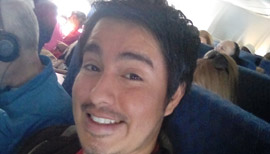
Guy from South America |
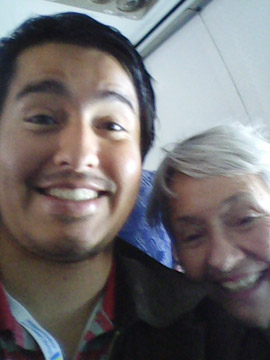
Apologizing for the mess we made |
We take a shuttle to the Sheraton Miami Airport Hotel and hook up with our San Diego travel pals – Bill, Judy and Patti. We take an Uber to Little Havana (Miami) for our evening outing.
We walk around the lively, friendly neighborhood and then pick out a quaint restaurant. A dynamo young waitress serves us a delicious Cuban dinner. She left Cuba a few years ago and tells us interesting stories that changed some assumptions that I had about Cuba. For example, education to her in Cuba is fascinating and enriching. She comes to America for a better education and is bored with learning some facts in order to pass the tests. Also, in Cuba, she goes with friends to museums, performances or other cultural attractions. Her American friends are only interested in going to bars.
10/9/16 – To Camaguey, Cuba
After a so-so breakfast at the hotel, we meet with The Grand Circle travel group. We learn a little about each other and then fill out a packet of official papers – serious business. We are not TOURISTS, but rather traveling on a PEOPLE TO PEOPLE CULTURAL EXCHANGE program. This is all required because of the U.S. embargo.
We arrive at the Miami airport in the early afternoon. Bill and I grab a burger and a beer and then board the plane with our new friends in the “people-to-people cultural exchange” program.
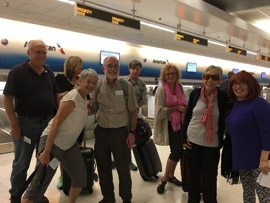
Our traveling companions |
Luckily, we have an uneventful hour-long flight from Miami. This time, wedged in between us (me by the window and Bill in the aisle seat) was a quiet Cuban man who speaks as much English as I do Spanish. He sits with his arms crossed staring at his blank monitor screen. For some odd reason, he reaches over and turns off my monitor – then I start pushing buttons on his screen. In no time we bound over some silliness. On the interactive map section on our screens, we swipe our fingers across each other’s screens, constantly changing the angles and positions of the plane and surrounding landscapes. How could that be fun!?! But it was!

Flying to Cuba |

Flying to Cuba |
About 3:00 we land and de-plane in Camaguey, Cuba! We meet Raul, our guide and board the big, comfy air-conditioned bus along with 18 other fellow travelers.
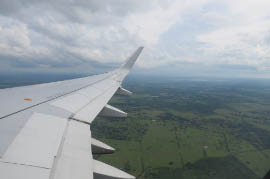
Miami to Camaguey |

Camaguey Airport |

Camaguey Airport |

Camaguey Airport |
Driving into the town of Camaguey is like driving into the postcards I’ve seen of Cuba. Everywhere I look are laid back, happy people hanging out amongst the once-elegant old Spanish colonial buildings with an occasional old classic car parked along the curb.
The cars trigger a synapse in my brain that opens the long lost Nancy’s “coming of age” file. The memories come flooding back like visions of the 1954 Food Fairlane that my Dad proudly purchased and the 1962 Impala my boyfriend drove to pick me up for dates.
Camaguey -- what a magical town. Founded in 1514 as a port and then relocated inland, it was one of the original seven “villas” of early Spanish Cuba. The twisty streets and narrow squares, designed to confuse the marauding pirates, still confuse us wandering tourists. Sir Henry Morgan once sacked the city. Here’s some every day streets scenes around town.
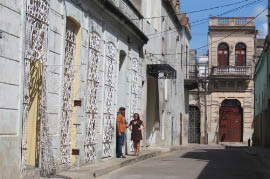
Camaguey |

Camaguey |
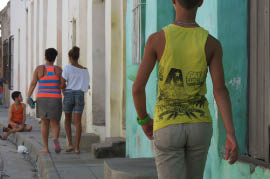
Camaguey |

Camaguey |
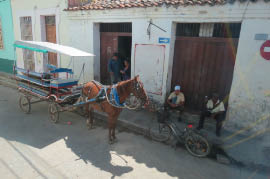
Camaguey |

Camaguey |
Our tour bus which happens to be the only one in town, parks right outside a lively plaza filled with people and motion and life.

Camaguey |
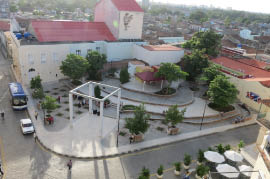
Camaguey |
We walk a few steps to our hotel, the Encanto Santa Maria. After a rum and coke welcoming drink in the classy old hotel lobby, we go to our rooms, unpack and take a little time to refresh before dinner.
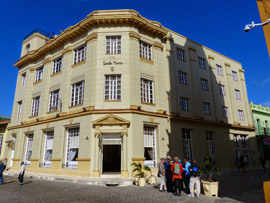
Hotel Santa Maria |

Hotel Santa Maria |
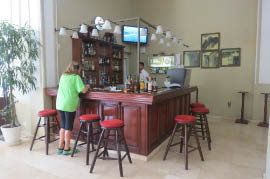
Hotel Santa Maria |

Hotel Santa Maria |
For dinner, we walk down the old side streets to the Meson del Principe, one of the many small family-run paladares – part of Cuba’s new wave of privately-owned restaurants. It is a lively, authentic old place with a separate air-conditioned room for us wimpy Americans. The food is over-cooked, but the drinks are generous and the music divine. An animated trio fills the room with old nostalgic tunes with a distinctive Latin vibe. We are a happy group.
10/10/16 – Camaguey
We enjoy a rooftop breakfast at the hotel and take in the morning views.
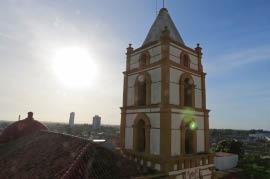
View from our hotel |

View from our hotel |

View from our hotel |
After breakfast, we tour the town – an amazing UNESCO World Heritage Site. We board bici-taxis – Cuba’s version of rickshaws – to carry us through the narrow streets
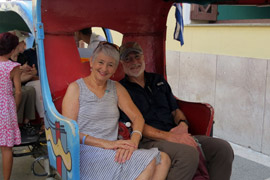
Touring Camaguey |

Touring Camaguey |

Touring Camaguey |
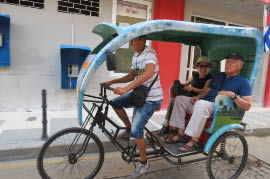
Touring Camaguey |

Touring Camaguey |
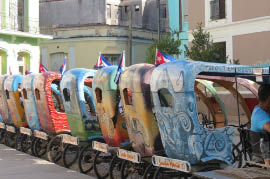
Touring Camaguey |

Touring Camaguey |

Touring Camaguey |

Touring Camaguey |

Touring Camaguey |
Our first stop is the city’s historical center where our bigger-than-life local guide points out the landmarks. I am taken by his deep, honey-toned voice, his knowledge, his stories and his CAN DO attitude. (He has that inspirational quality.)

Our guide in Camaguey |

Our guide in Camaguey |
We roam around the first square on our own. The blue building is a stunning government building. Pal Patti uses her charm and her Spanish to make friends with the guard in the lobby. He even lets her use the “facilities".
Something about a tree growing prominently in the square is very important – Does anybody remember?
Overlooking the square below is a huge graphic mural of Ché that evokes revolutionary passions of bygone days. No wonder the people gather here for speeches and celebrations.

Camaguey |

Patti |

Camaguey |

Camaguey |
On the other side of the square is the Church of Cuba. The church has an “iffy” relationship with the government … but that’s much better than the previous non-relationship. Cubans say jokingly that they must be the most religious people in the world because they must depend on miracles to survive.
Inside the church is a black Jesus with an exposed heart. The heart looks a little too much like the medical model of a heart that I see in my cardiologist’s office.
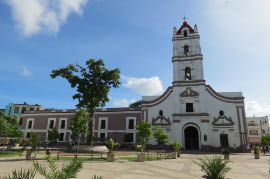
Camaguey |

Camaguey |

Camaguey |

Camaguey |
Second stop is the city’s once grand theater, constructed in 1850, but now, in need of repair. Theaters are cheap in Cuba. Citizens have easy access to lots of cultural events because of government subsidies and Cuba’s high priority on the arts.

Camaguey |
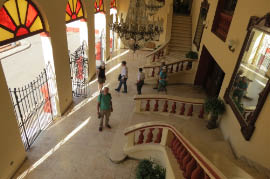
Camaguey |
Third stop is at square (Plaza del Carmen) with life-like bronze sculptures of everyday people. The charming statues were created by Martha Jimenez, a well-known Cuban artist, We visit her delightful gallery located on the square. There is such humor and love in her work. Wish I’d purchased one of her pieces – oh well.

Plaza del Carmen |
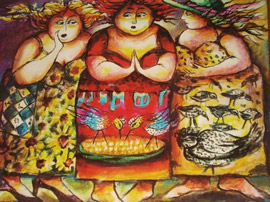
Plaza del Carmen |

Plaza del Carmen |

Plaza del Carmen |

Plaza del Carmen |

Plaza del Carmen |
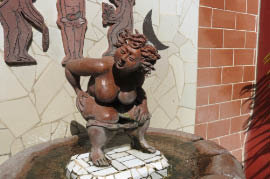
Plaza del Carmen |

Plaza del Carmen |

Plaza del Carmen |

Plaza del Carmen |
The rest of our day is filled with a series of wonderful galleries, each one creative and unique. Pepe’s (Jose D. Gutierrez) leather-sculptures have real soul. He also makes some of his creations from tobacco leaves.
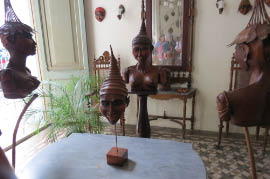
Pepe’s leather-sculptures |

Pepe’s leather-sculptures |

Pepe’s leather-sculptures |
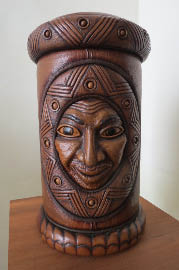
Pepe’s leather-sculptures |
I am blown away by Magdiel Garcia Almanza's studio. (Sorry the photo of him is out of focus.) His interactive wood sculptures are crazy and whimsical and the naughty ones stole my heart.
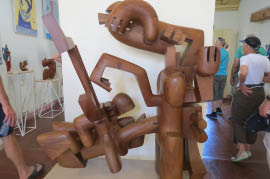
Magdiel Garcia Almanza's studio |

Magdiel Garcia Almanza's studio |

Magdiel Garcia Almanza's studio |
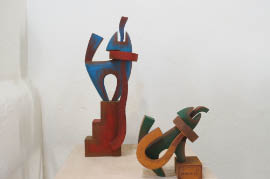
Magdiel Garcia Almanza's studio |
Next we visit Eduardo Rosales, another wild and crazy Cuban artist. He was studying to be a lawyer when destiny lead him to art. As a law student, he had serious intestinal problems. Fascinated by his own x-rays, he used them as backdrops for his art (pictured below). The x-ray paintings were OK, but I am most intrigued by his series of Aboricinies, inspired by the nearby cave paintings.

Eduardo Rosales |

Eduardo Rosales |

Eduardo Rosales |

Eduardo Rosales |

Eduardo Rosales |

Eduardo Rosales |
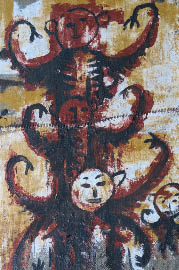
Eduardo Rosales |

Eduardo Rosales |
Next we visit the home and pottery studio of Carlos Alberto Casanova. Father Carlos and son entertain us with an amazing pottery throwing demonstration creating perfect pots in just minutes. Rebecca and Vicki give it a try -- not as easy as the experts make it look. Our group really enjoys the visit and the warmth of the family. Back on the bus, Raul tells us how inspired he is by the Casanova family’s hard work and success. Every time he sees them, he says to himself, “All you have to do is just try!”

Carlos Alberto Casanova |
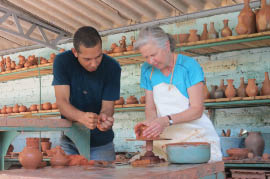
Carlos's Son |
After a busy day of art, we come back to the hotel to meet a student from the Jose White Conservatory. She is shy, beautiful and a gifted musician (vocalist). We learn that she was selected by the Cuban government to study music when she was in elementary school living in a poor village. She moved to the city (Camaguey) to study classical singing. 4 years later, she passes a difficult exam and goes on to study in high school … then college and then graduate school. She is now a director in Camaguey’s chorus making about $250 a month. She struggles financially. She must decide whether to continue her music career or return to the village to help her family. Tough choice. I like her very much – but I am partial to young, talented musicians because of my granddaughter.
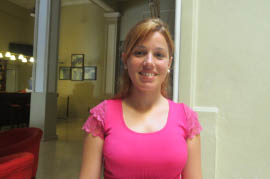
Director of Camaguey’s Chorus |
After we say “good-bye,” we walk to the Agramonte Revolution Square, where the town began in the 16th century. A bronze statue honors General Ignacio Agramonte, Camaguey’s first real leader in the struggles for freedom against Spain.
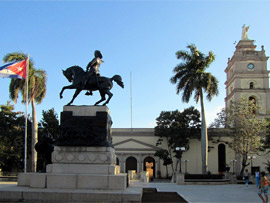
Agramonte Revolution Square |
On the square is the home (rather home-studio-gallery) of Joel Jover and his wife Ileana Sanchez – both prominent contemporary painters and collectors. Married for some 40 years, they have 2 children and at least one dog. Joel guides us through the house while Ileana naps
Their old Spanish mansion put us all into visual overload with so much stuff to absorb. The walls, from floor to ceiling, are covered with their paintings. Ileana saturates her creations with bright colors while Joel’s goes to the muted side. Mixed in with their artwork are wild and crazy collections – a real hodgepodge of a museum. (Even a collection of children’s riding toy horses – like the one we bought for our daughter when she was 2.)
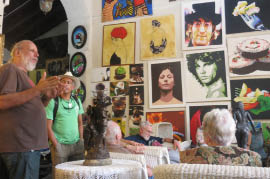
Joel Jover and Ileana Sanchez's Gallery |

Joel Jover and Ileana Sanchez's Gallery |

Joel Jover and Ileana Sanchez's Gallery |

Joel Jover and Ileana Sanchez's Gallery |

Joel Jover and Ileana Sanchez's Gallery |

Joel Jover and Ileana Sanchez's Gallery |

Jover and Sanchez Gallery |

Jover and Sanchez Gallery |
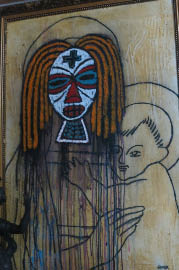
Jover and Sanchez Gallery |
Joel is a respected artist and professor. Ileana is also well known in her own right. She made her mark throughout Camaguey with her wonderful funky scenes on bicitaxis, buildings, alleyways – you name it. Her signature motif is the “Blue Cat” designs – supposedly originally from the new breed of Russian cat in Cuba that is grey-blue (hence, Blue Cat).
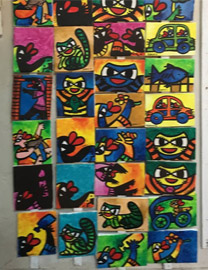
Blue Cat Design |

Blue Cat Design |
Pal Patti and I explore the house, excited by all the visuals. Patti points out the subtle snake in a painting. I notice the snake outlines Joel’s profile. Joel confirms that it is indeed a self-portrait. (Pictured below – snake self portrait pictures with a side view of Joel’s head below.) We say good-bye to Joel, another way cool Cuban artist!
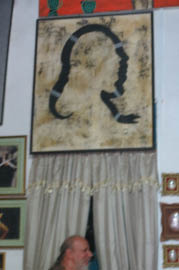
Jover and Sanchez Gallery |

Jover and Sanchez Gallery |
NOTE: We notice large pots everywhere throughout the city. This one happens to be in Joel’s backyard. Later we learn that Camaguey is known as the city of "tinajones" or large pots. Several are antiques dating back to the 1800’s. They are used to hold water. Even today, Raul says there is no place in Cuba where you could get water 24 hours a day. You have to buy water and fill your cistern – or store it in “tinajones”.
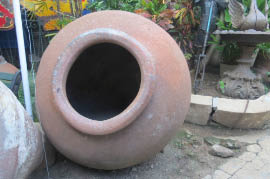
Tinajones |
We have dinner at another family-run paladar– excellent seasoned with salsa music.
WOW what a day. Love this place – really touches the heart.
10/11/16 – Camaguey and King Ranch – My Birthday!
We start our day with a visit to the En Dedans Dance Company. En Dedans is a French term meaning “inward.” The dance style merges contemporary dance with neoclassical ballet – if that means anything to anyone. We meet the director and then watch a private rehearsal. Afterwards, we get to know some of the dancers and then offer gifts from U.S. Hope there was a new pair of ballet shoes among those gifts!
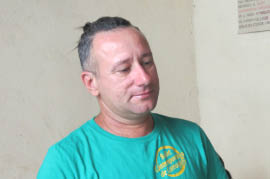
En Dedans Dance Company, Director |
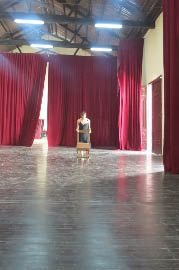
En Dedans Dance Company |

En Dedans Dance Company |

En Dedans Dance Company |
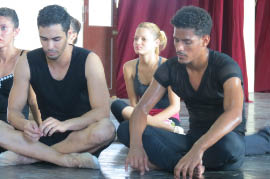
En Dedans Dance Company |

En Dedans Dance Company |
We say good-bye to the dancers and board the bus to travel 50 miles north to the King Ranch, famous to us Texans. In 1952, the main King Ranch in Texas added another ranch here in Cuba. The timing was bad because in 1959 Castro “appropriated” 38,000 acres of the Cuba King Ranch and sent the Texans packing.
There is very little traffic on the road to the Ranch. We see the Cuban countryside -- lots of greenery, occasional cows and cowboys. We drive by miles and miles of a wicked, gnarly, invasive bush called marabous bushes. It is next to impossible to control and covers about 30% - 40% of the landscape. The bad news is that marabous gobble up farmlands and grazing pastures. The good news is that marabous is termite resistant making it excellent to use for posts, furniture, charcoal, and musical instruments. I learn from Goggle that Cuban farmers are also harvesting the plant to produce vegetable coal to export it to the European countries for millions of dollars.
In spite of the green landscape, we learn that Cuba is in a severe drought which is affecting the agricultural production. They've had none of the usual floods for 10-12 years.
Raul says the biggest agricultural problems are (1) there is no longer enough difference between day and night temperatures required for the plants to produce; and (2) the island is losing fertile land because of the rising ocean level. Guess what - global warming is real here!
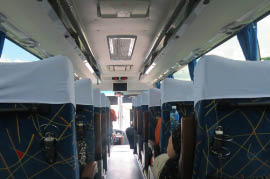
Bus to King Ranch |
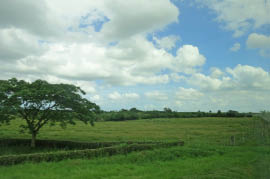
King Ranch |

King Ranch |

King Ranch |
We get a very warm welcome at the ranch. A trio of cowboys leads us to the dining hall, and then we meet our loveable guide. He started his long career at the ranch as a cowboy. He tells us that cowboys today aren’t what they use to be. They don’t work as hard and don’t take pride in their cowboy appearance – maybe the communist years affected the cowboy’s work ethic. Our guide takes us around the grounds. He shows us a friendly, pet rooster and a tree that produces little berries. The folks here use the juice from the berries as “Elmer’s Glue.” (Because of the long embargo, one must be very resourceful in Cuba.)

King Ranch |

King Ranch |

King Ranch |
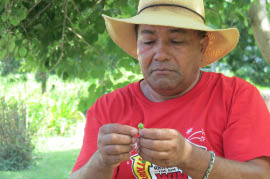
King Ranch |
We have a beautiful, tasty lunch in the ranch’s private dining room. A terrific group of musicians serenade us with salsa tunes. Judy, with her infectious party spirit, got most of us (except for my Bill) up grooving with the music.

King Ranch |

King Ranch |

King Ranch |
To warm the cockles of our American hearts, the King Ranch showed us a table with an inlay U.S. flag design on the top. The original King Ranch owners (pre 1959) hid it away and now it’s safe to haul it out and show it off, especially to American tourists.
We learn that Castro often stayed in one of the rooms. He liked the Ranch, probably was a nice retreat from his jungle camp. This is the bathroom he used – don’t think it’s been remodeled from the time of his occupancy. In any case, my claim to fame is that I used the same facilities as Castro!

King Ranch |
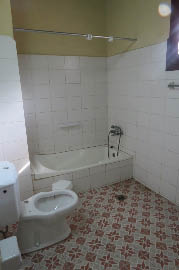
King Ranch |
After lunch and a potty break (in Castro’s bathroom), a horse-drawn cart takes us on a tour. These carts are not just saved for tourists – they're one of the main modes of transportation. Our driver was very cute with gorgeous blue eyes. My cart-mates – Pal Patti and Bill – are also cute, in a different way.
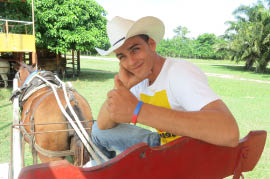 King Ranch King Ranch |
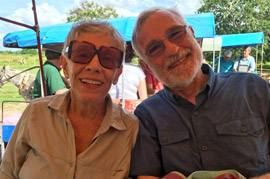
Patti and Bill |
We stop to see a mini-rodeo and some serious lassoing and the calf-roping demonstrations. Those Cuban cowboys are good – and I thought their attire looked fine!
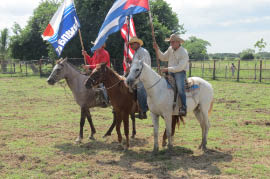
Rodeo at King Ranch |

Rodeo at King Ranch |

Rodeo at King Ranch |

Rodeo at King Ranch |
We continue down the country road to a local village that is home to people who work on the ranch. Right outside the village are the remains of a time before the advent of cable TV. There are two desolate old outdoor theaters for the village people. One was a drive-in theater (without cars) where folks gathered to watch a weekly movie. The other was later added when the first village TV arrived on the scene. Now both are overgrown with weeds, ruins of a by-gone time.
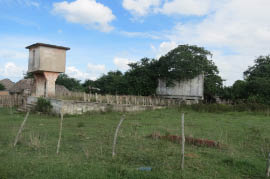
Old Outdoor Theater at King Ranch |
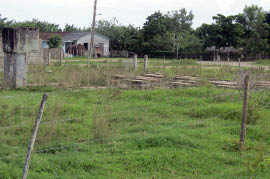
Old Outdoor Theater at King Ranch |
There are some thatched-roofed houses in this village that is frozen in time and cut off from the outside world. The curious friendly villagers greet us at the carts and give us a warm welcome. Americans are rare here. A strong community spirit permeates the whole place.
Our guide tells us that the community comes together to build a house, just like the Amish. They wait for the quarter moon to cut down the wood. Following the moon cycle is not because of some ancient belief, but rather, when there is a new moon, the trees are full of sap which termites love. Very clever folks!

Village at King Ranch |

Village at King Ranch |
I am disappointed that we didn’t get to visit the local King Ranch school. Raul and Barbara from our group, stop in for a quick visit to deliver the schools supplies we brought as gifts. We did visit the house right across the street.

Village at King Ranch |
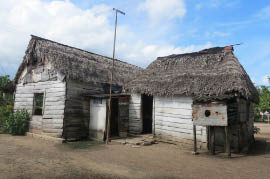
Village at King Ranch |
Our warm and humble hostess greets us at her front gate. Retired from the King Ranch, she is proud of her modest home. I like the simple, homey place – no downsizing required here. We learn that a 23-year-old geeky guy in the village is quite a clever inventor. He creates makeshift extension cords and cable TV boxes out of whatever he can find. After a brief tour of the inside of the house, we go to her backyard to sample freshly squeezed sugar cane and a variety of fruits.
It’s a very peaceful place. However, a week earlier, Hurricane Matthew was heading toward Cuba. To prepare, the entire village helps each other, boarding up windows and traveling to an evacuation center. The villagers spend one night away and return the next day to see their village still intact. Such is life in hurricane alley.

Village House |

Village House |
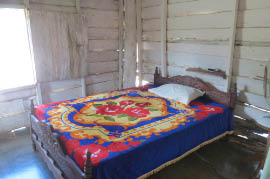
Village House |

Village House |
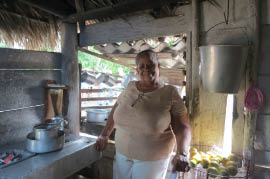
Village House |
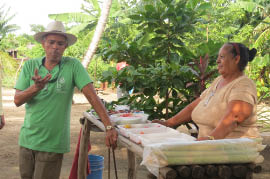
Village House |
Our horse drawn carts take us back to King’s Ranch where we board the bus to go back to the hotel.
At the hotel lobby, a delicious birthday cake awaits me and Beth, another fellow traveler, born on Oct. 11 (along with Eleanor Roosevelt). After a celebration drink and a very out of tune rendition of “Happy Birthday,” we devour the cake. Nobody took photos of us birthday girls – which is probably just as well.
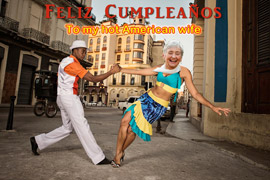
Nancy's Birthday Card |

Birthday Cake |
For dinner, Judy and her Bill, me and my Bill walk to a place called “Carmen’s.” It was hopping with locals. We liked the Paella we shared … but I was disappointed with my over-cooked shrimp dish. Such is the tough life of a traveler especially one who is spoiled rotten. We walk back to the hotel down the twisty streets. Camaguey is one cool place – sad to be leaving in the morning.
10/12/16 – Camaguey to Remedios
We leave Camaguey in a little rain. Good-bye to our wonderful hotel, good-bye to the square. Our next destination is Remedios, 150 miles away. I watch the scenes from the bus window. The time goes fast because Raul tells a fascinating story about one of Che’s love-interests. Her name was Tamara Bunke, also known as Tania the Guerrilla. She was an Argentine-born German communist revolutionary (and most likely a double agent). Che and Tania hooked up after the Cuba Revolution while he was making plans to start a revolution in Bolivia. Plans went awry and both ended up being killed. That’s the stuff mini-series are made of.
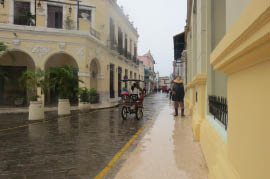
Leaving Camaguey |

Leaving Camaguey |

On the way to Remedios |
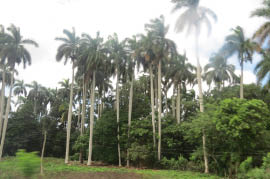
On the way to Remedios |
We make a pit stop along the way. Judy finds her way to the bar (ha ha – picture was a set up photo opt). Patti and I take a walk out back. Inspired by Raul’s story, I pretend to be a revolutionary Guerrilla fighter.

On the way to Remedios |

Judy at the bar |

Patti |
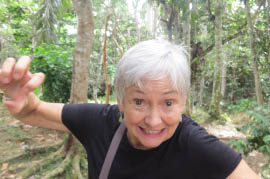
Revolutionary Nancy |
We arrive in Remedios at lunchtime. I immediately feel connected to this charming old colonial town founded in 1513. Our hotel, Hotel Camino Del Principe, is right in the heart of town by a peaceful town plaza, Plaza Marti.
We enjoy an elegant lunch at the hotel while two young musicians fill the room with classic melodies. Of course, I bond with the violinist, another talented young aspiring musician (like my granddaughter).
By the way, lunch came in the form of a rubik's cube constructed with 1/3 inch cubes of ham, cheese, mango, etc. Wish I snapped a photo to document such creative plating.
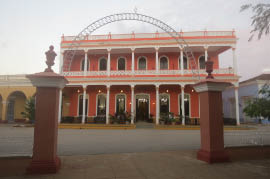
Hotel Camino Del Principe |
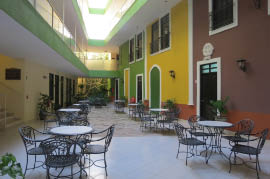
Hotel Camino Del Principe |

Hotel Camino Del Principe |

Hotel Camino Del Principe |
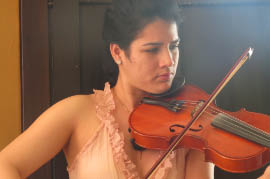
Violinist at Hotel Camino Del Principe |
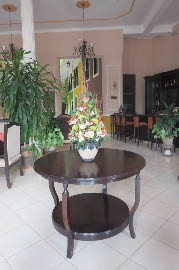
Hotel Camino Del Principe |
After lunch, we walk to a casa / gallery to meet a key community leader in Remedios. I don’t recall his name so I’ll just call him Don Juan because he’s handsome and charismatic. (Later I learn his name is Rao.) The gals in the group swooned when he told us that his mother is the love of his life.
A real mover and shaker in town, he is in “the old car drivers’ club” and also organizes a huge, big deal yearly carnival called “Las Parrandas.” It’s a wild and crazy religious carnival held during the holidays with the grand finale on Christmas Eve. The festival begin in 1820 by a clever priest who wanted get more town folks to come out to the Christmas season midnight masses, He gathered groups of kids and gave them tin cans, pots, pans, and spoons for noise makers. They ran around the village making lots of noise to get the locals out to midnight mass.
The idea lasted over the years and took on a life of its own. The noisy kids have become a massive festival that puts New Orleans Mardi Gras to shame and puts Remedios at the epi-center of the celebration. It starts about 3 pm on Dec. 24th and goes well into the next morning. There’s a lot of drinking, cigar smoking, pig and bean eating, serious firework explosions, music, dancing, and your basic running wild and acting crazy in the streets. (There are also a lot of injuries which add to the excitement!)
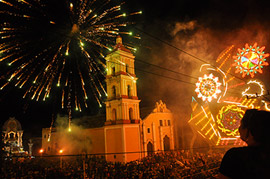
Remedios Parrandas |
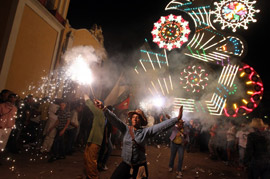
Remedios Parrandas |

Remedios |
The preparations take months, and involve making homemade fireworks, extravagant floats, costumes and other grandiose decorations for the festival. The town is divided right down the middle into two neighborhoods that compete for the best float -- San Salvador (mascot is the rooster) and El Carmen (mascot is the hawk). There is a very serious rivalry. Both groups spend the entire year secretly creating new ways to make the greatest float and tower ever for the final show on Christmas Eve.
“Don Juan,” leads the El Carmen hawks. Go Hawks. He shows us intricate plans for floats in by-gone years and tells us stories about “the top secret” operations.
We then go with him to the El Carmen carrozas (float) workshop -- a large, noisy factory where workers are busy building colorful floats. I am amazed at the elaborate creations, especially given the limited supplies. One must be very frugal and clever to come up with these “Rose Bowl” caliber floats, given limited budgets and an embargo that blocks every day supplies. They collect and save everything like pieces of foil or anything shiny. They go to stores all over Cuba several times a year to buy the hundreds of light bulbs required to light the float and tower.
The bizarre factory is alive with fun and fantasy. I feel like I’m in a Fellini movie. After a while, Patti and I grow weary of the construction noises and strange sites. We retreat to nature outside and take a little walk in the tranquility of the neighborhood.

El Carmen carrozas (float) workshop |

El Carmen carrozas (float) workshop |
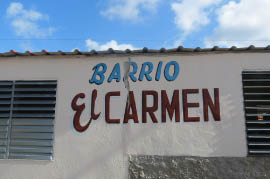
El Carmen carrozas (float) workshop |

El Carmen carrozas (float) workshop |

El Carmen carrozas (float) workshop |
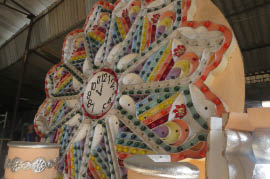
El Carmen carrozas (float) workshop |

El Carmen carrozas (float) workshop |

El Carmen carrozas (float) workshop |

El Carmen carrozas (float) workshop |

El Carmen carrozas (float) workshop |
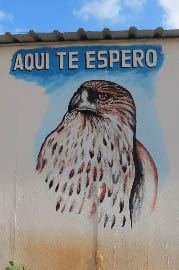
El Carman Workshop |

El Carman Workshop |
We return to the hotel in time for “Happy Hour" and then walk to Casa La Paloma for dinner outside. It’s a happy, beautiful place filled with excellent food (slow roasted pig cooked outside), music, dancing and a couple celebrating their 40th anniversary. Our adorable party girl Judy gets us all into the salsa spirit (except for my Bill). She’s wonderful. Also among the many wonderful travelers are Mike and Rebecca. (By the way, Mike is the “perfect” husband.) I snapped this photo outside our hotel.

Mike and Rebecca |
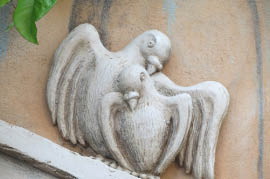
La Paloma |
10/13/16 –Remedios
After breakfast, I explore Remedios on my own while Bill catches up on Facebook in the main square.

Remedios |
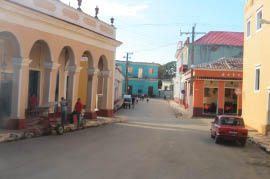
Remedios |

Remedios |

Remedios |
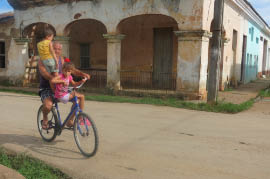
Remedios |
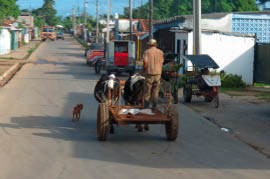
Remedios |

Remedios |

Remedios |

Remedios |
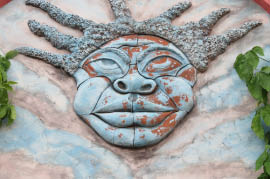
Remedios |
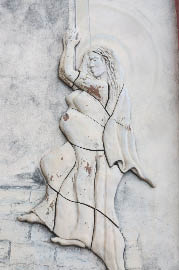
Remedios |

Remedios |
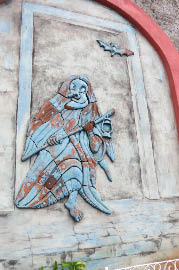
Remedios |
We board the bus to go about 40 miles to city of Santa Clara to see the Che Guevara Monument / Mausoleum / Museum. We make our first stop at the mausoleum and then the museum where cameras are forbidden.
The dim and somber cave-like mausoleum contains the walled tombs of Che along with 29 of his rebel soldiers killed in the 1967 Bolivia uprising. Che was buried here in the mausoleum in 1997 after his exhumed remains were discovered in Bolivia and returned to Cuba.
Next we visit Che’s museum. The black and white photos taken of Che from childhood until Bolivia are wonderful. He is handsome and charismatic. Also on display are many of his personal artifacts -- doctor’s coat, medical instruments, smoking pipes, inhaler used during his asthma attacks, weapons, his personal transistor radio and lots of his personal manuscripts. The displays are in Spanish, but I still get a good sense of the man.
I retrieve my camera and head to the monument. Surrounding the monument are carvings and inscriptions detailing the battle of Santa Clara while a bronze 22-foot statue of Ernesto "Che" Guevara rises up from center.

Che Guevara Monument Museum |

Che Guevara Monument |
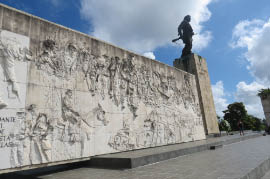
Che Guevara Monument |
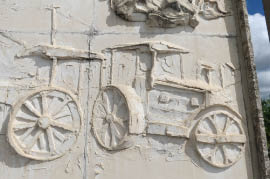
Che Guevara Monument |
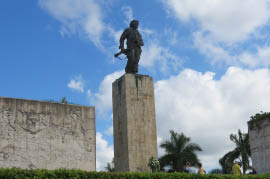
Che Guevara Monument |
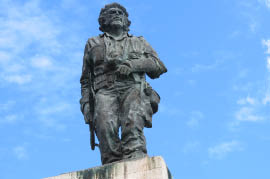
Che Guevara Monument |
Next, we take a short bus ride to see the historic boxcar museum at the sight of a massive train wreck in the 1958 Battle of Santa Clara. One of the Batista’s military supply trains was scheduled to arrive in Santa Clara in late December of 1958. Under the command of Che Guevara, a small band of guerilla fighters used a bulldozer/tractor from a local university to destroy a section of the iron railroad train tracks. When they finished the demolition, they left a bulldozer parked on top. The train barrels down on the demolished tracks, derails and scatters train cars filled with Batista soldiers, weaponry and explosives over the landscape. To add insult to injury, 150 guerilla fighters then throw Molotov cocktails into the wrecked cars. It didn’t take the rebels long to capture the train. Batista’s officers poured out of the train, apparently asking for a truce. The soldiers eventually joined Guevara's side, saying that they were tired of fighting against their own people.
This was a great victory and the final siege of the Cuban Revolution. Cuban dictator Batista fled into exile while Castro prepared to take over Cuba (and we all know the rest of the story).
Santa Clara is on a busy train route and many people and goods pour through here on the rails.
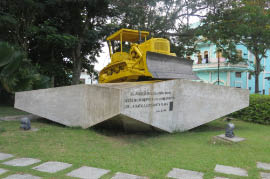
Battle of Santa Clara Site |
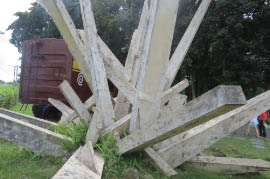
Battle of Santa Clara Site |
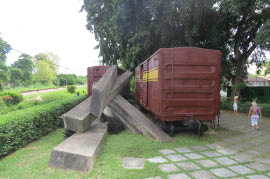
Battle of Santa Clara Site |
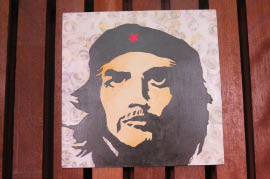
Battle of Santa Clara Site |
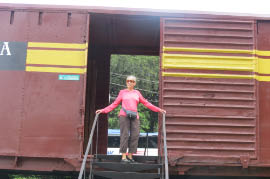
Battle of Santa Clara Site |
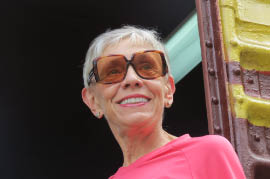
Patti at Battle of Santa Clara Site |
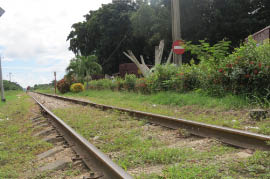
Battle of Santa Clara Site |
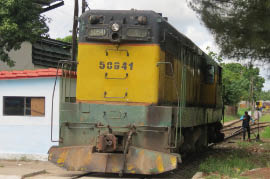
Battle of Santa Clara Site |
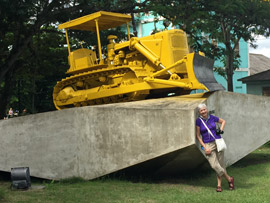
Battle of Santa Clara Site |
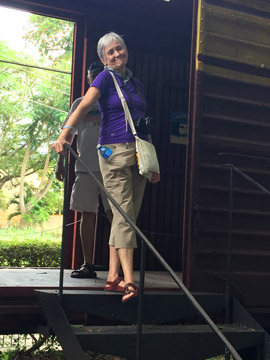
Nancy at Battle of Santa Clara Site |
We board the bus for a short ride to the heart of Santa Clara for lunch at Casona Jover, a local paladar. Food was good and lots of it. I’m sure I’m getting fat on this high caloric diet.
After lunch, we stroll (rather waddle) to the main square (Parque Leoncio Vidal) and have some free time to explore on our own. Bill is hot to buy an internet card (and find a connection) so I hook up with Judy and Bill to explore some old colonial buildings on the square – a library, an opera house, a mansion that charged an entrance fee, but well worth it.
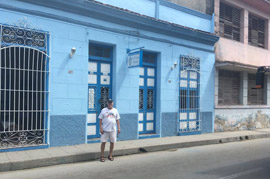
Santa Clara |
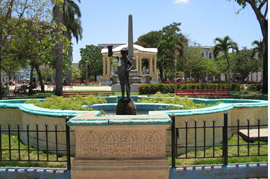
Santa Clara Main Square |

Santa Clara |

Santa Clara |
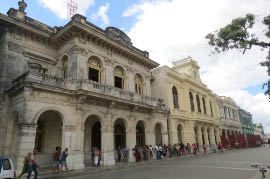
Santa Clara |

Santa Clara |

Santa Clara |
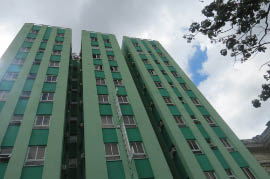
Santa Clara |
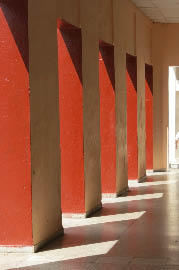
Santa Clara |

Santa Clara |

Santa Clara |
It’s a hot, steamy afternoon and I am glad when the air conditioned bus takes us back to Remedios. Santa Clara is not at all like the charming colonial towns of Remedios and Camaguey. There are more people, more city hustle and bustle, more trash on the streets, more beggars and more ugly buildings inspired by the Russians.
Back at the hotel, we do some “rum” tasting and Raul gives us a lesson in cigar smoking. (As you can see, Raul is very cool guy.)

Raul's Cigar Lesson |

Our group |
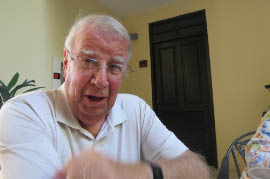
Denny |
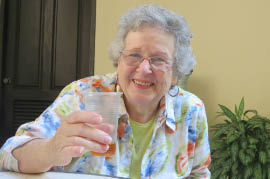
Linda |

Raul |

Raul |
Memory doesn’t serve me well, but I think we took a bus to an unscheduled restaurant on the outskirts of town. It was OK – but I prefer walking down the old streets and squares and dining in the wonderful old colonial buildings.
10/14/16 –Remedios
After breakfast, I dash out to capture Remedios on a rainy morning – don’t get much rain in southern California.
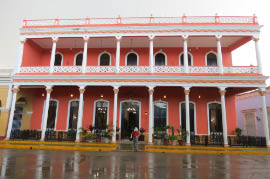
Remedios in the rain |

Remedios in the rain |
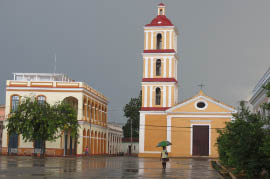 Remedios in the rain Remedios in the rain |
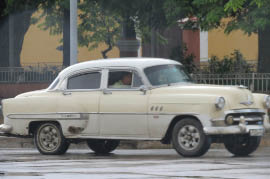 Remedios in the rain Remedios in the rain |
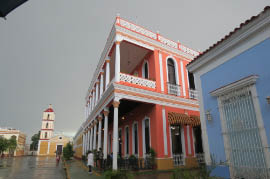 Remedios in the rain Remedios in the rain |
 Remedios in the rain Remedios in the rain |
 Remedios in the rain Remedios in the rain |
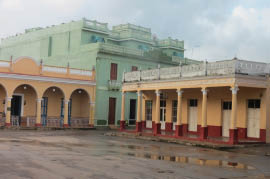 Remedios in the rain Remedios in the rain |

Remedios in the rain |
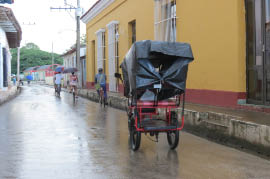
Remedios in the rain |

Remedios in the rain |
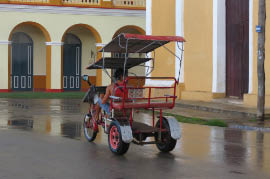
Remedios in the rain |

Remedios in the rain |
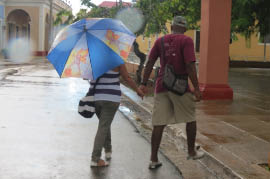
Remedios in the rain |
Our first visit of the day is to a late 18th-century church, Iglesia de San Juan Bautista. I checked out the church earlier in the morning while I was on my personal photographic run while they were having mass. Only about 20 were in attendance along with one lovely lady from our group -- Linda, of Linda and Denny.
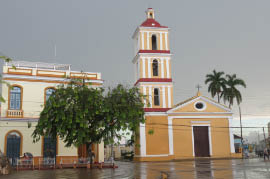
Iglesia de San Juan Bautista |
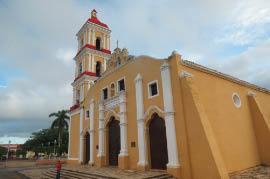
Iglesia de San Juan Bautista |
The church was built in 1692 on the remains of a previous church built in 1570, making it the oldest church in Cuba. The carved ceiling is the only thing intact from the 1570 church.
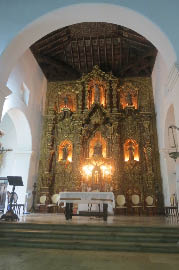
Iglesia de San Juan Bautista |
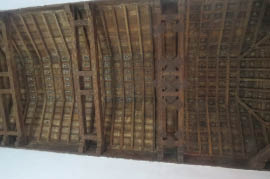
Iglesia de San Juan Bautista |
Raul, our designated translator, leads a discussion with a Priest (or is it Father?). He is a sweet, gentle soul. He tells us about some of the social outreach programs his church offers. Some of the parishioners here do laundry and provide a daily lunch for seniors in the neighborhood. He says that the relationship between the church and the government is much better than in the past, but the church still must be careful. Also, because the current generation has no memory of church-going, it is difficult to build a congregation.

Raul and the priest |
A main attraction of the church is a beautifully decorated gold altar. During the colonial years, Remedios had a real pirate problem so the church people painted the altar white to hide the gold. In 1944, during a remodel, the gold altar was discovered and restored.
Another attraction of this church is a clearly pregnant Madonna statue, said to be the only of its kind in Cuba.

Iglesia de San Juan Bautista |
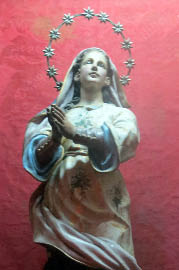
Iglesia de San Juan Bautista |
There are also catacombs in the church where town leaders were buried.
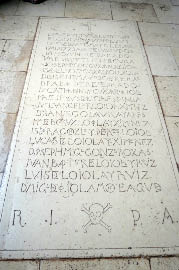
Catacombs |
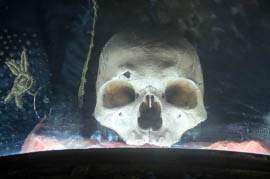
Catacombs |
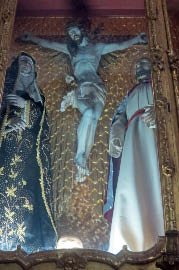
Iglesia de San Juan Bautista |

Iglesia de San Juan Bautista |

Iglesia de San Juan Bautista |
We board the bus and travel a short distance to Camajuani to visit the Tabacuba tobacco factory. We are forbidden to take pictures. An official looking guard follows us everywhere. They are very serious about keeping their cigar making secrets. (Photos shown below are courtesy of the internet.)
A lively supervisor shows us around. There is an extra level of excitement today because just this very morning, U.S. allowed Americans to bring back up to 100 Cuba cigars instead of the 5 or so previously allowed. A new day is dawning in Cuba.
We watch employees at their stations rolling cigars by hand, one after another. Quality is king in these operations. Everyone is busy and intent on their jobs, except for the new trainees, who look so very bored. We visit a tiny room where expert cigar smokers “taste test” the flavors. Chris and I become bored packed into the room with our group. We go out into the hallway and dance to the piped-in Latin tunes. The serious guard watches us very closely, then flashes a little smile. Cuba is so fun!
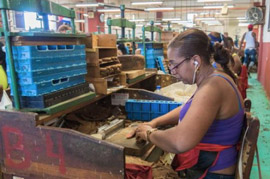
Tabacuba Tobacco Factory |
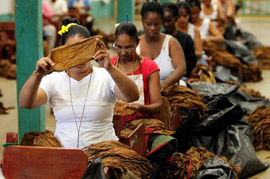
Tabacuba Tobacco Factory |
We drive to another little town with much more wear and tear than Remedios. Here, we visit an antique printing shop, still in operation. In 1963 the shop was nationalized. The owner is proud of his century-old business and still uses the equipment his great grandfather brought from Italy. He is very sad that typesetting is a dying art. One piece of equipment they still use was built in 1861 – around the time of the U.S. Civil war. One good way to look at it is that if it weren’t for this dusty old shop, most of this ancient printing equipment would be long gone. However, I found the long, endless discussions of benefits of antiquated printing techniques very tedious and boring (with no salsa music piped in for the dancing diversion.)
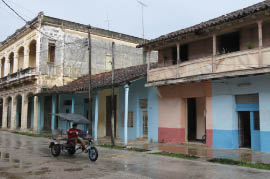
Camajuani |
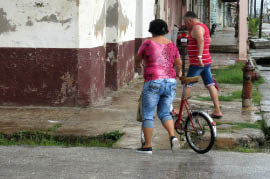
Camajuani |
 Camajuani Camajuani |
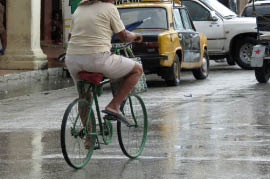 Camajuani Camajuani |

Old print shop |

Old print shop |

Old print shop |

Old print shop |
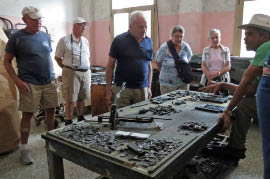
Old print shop |
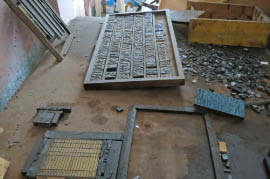 Old print shop Old print shop |
We eat lunch at another local paladar, En Familia – the gluttony continues.
Next stop is the Museo de Agroindustria Azucarero, a local museum focusing on the history of slave culture, the sugar industry, and the pre-diesel locomotives that once transported sugar cane to local factories.
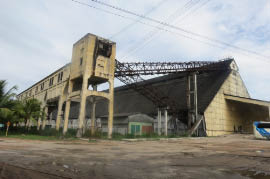
Sugar Mill Museum |
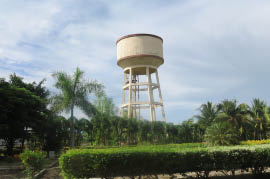
Sugar Mill Museum |
Part of the museum is an actual working factory. In fact, the employees were busy celebrating some holiday. There is a loud band and lots of beer, making it difficult to hear our guide.
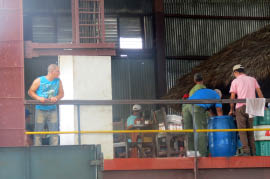
Sugar Mill Museum |
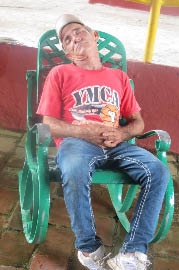
Sugar Mill Museum |
At the entrance, we buy freshly squeezed pure sugar cane (with an extra charge to add some rum). All I needed was one little sip of that sugar drink – thank goodness I’m not diabetic! On our sugar-high, we meet our guide.

Sugar Mill Museum |
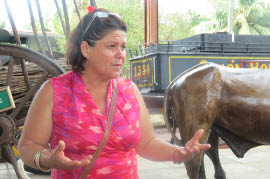
Sugar Mill Museum |
She did an excellent job giving us a better understanding of the whole sugar process. Statues of African slaves, who originally worked the cane, clearly show how tough life must have been.

Sugar Mill Museum |
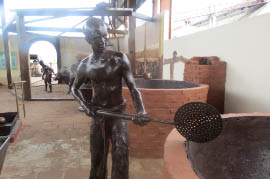
Sugar Mill Museum |
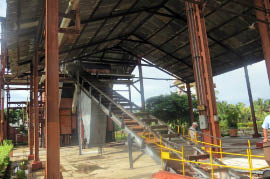
Sugar Mill Museum |
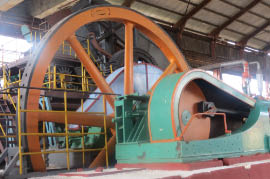
Sugar Mill Museum |
After exploring the museum, we walk to the nearby railroad tracks and locomotive museum. We pass by about 40 antique locomotives. Then we board an old fashioned steam train to take back to Remedios. It must be my lucky day because I get to ride up front with the train engineer and blow the whistle at each track crossing. (It was a little dangerous hanging on to my seat when the old engine is rocking and rolling. There are no safety regulations in Cuba and no suing – but lots and lots of fun!)

Train to Remedios |
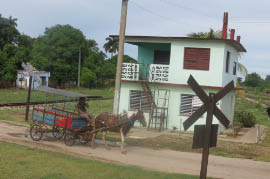
Train to Remedios |
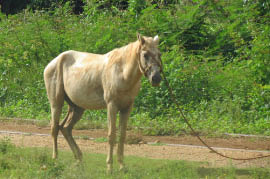
Train to Remedios |

Train to Remedios |
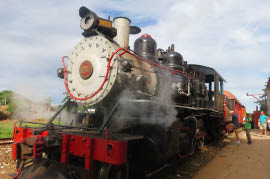
Train to Remedios |
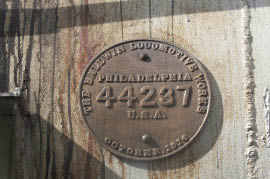
Train to Remedios |

Train to Remedios |
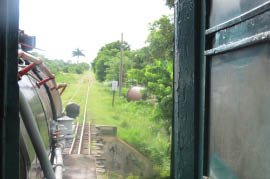
Train to Remedios |
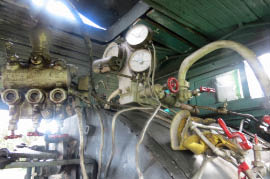
Train to Remedios |

Train to Remedios |

Train to Remedios |
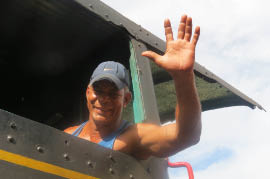
Train to Remedios |
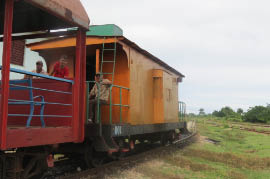
Train to Remedios |

Train to Remedios |
We arrive in Remedios and walk from the train station to the “Driver’s Bar,” a hang out for the "Old Car and Motorcycle" Club. Our own “Don Juan” organized this outing. We are treated to a free drink -- most have mojitos; I opt for a beer. Even a non-car person such as myself, I enjoy the lively discussion with the members of the car club. They talk about how long the cars have been in their families and the clever ways they maintain the old engines. For the last sixty years, Cubans have improvised to keep these old cars running. They may have parts in them from many other cars, or even a broken toaster! There’s a lot of passion surrounding these old cars. An American can buy one the cars, but they are not allowed to take it from Cuba.
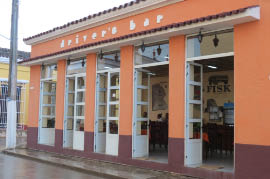
Driver’s Bar |
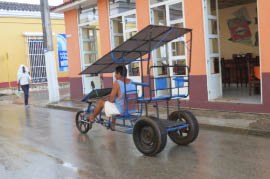
Driver’s Bar |
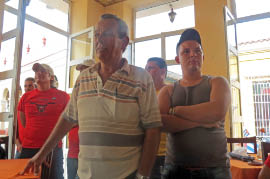
Driver’s Bar |

Driver’s Bar |

Driver’s Bar |
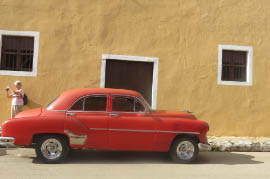
Car Club |
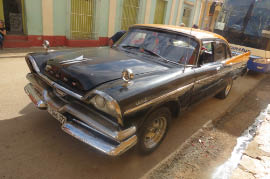
Car Club |

Car Club |
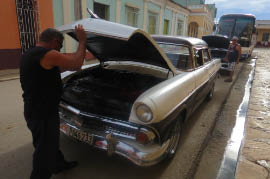
Car Club |

Car Club |

Car Club |
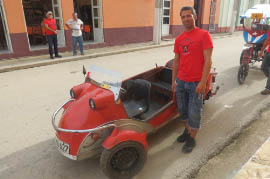
Car Club |
We pour out from the bar to check out the old cars. I snap photos and notice that my Bill is in the backseat of a car with 3 other of our traveling pals. Before I get his attention, they take off for a spin around town. In no time, all the cars and people are gone. Then “Don Juan” notices me from the Driver’s Bar and comes out to ask me what happened to my husband. I tell him Bill left me. He quickly arranges a ride for me with a most handsome young man in his sporty vehicle that’s a cross between a sports car and a motorcycle--a Messerschmitt. I enjoy the heck out of that ride. I am in picture-taking heaven. I take time out from my photo-taking to pretend I’m some prom queen smiling and waving at the people in the streets. What a nice, long beautiful ride. I come back to the hotel on a natural high. Bill greets me with a “Where have you been?” – Don’t even go there!
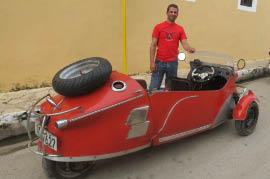
Ride in a Messerschmitt |

Ride in a Messerschmitt |

Ride in a Messerschmitt |

Ride in a Messerschmitt |
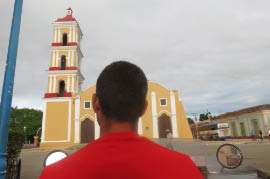
Ride in a Messerschmitt |

Ride in a Messerschmitt |
Our factory friends (and some members of the old Car Club) invite us to a spur-of-the-moment party. I have a strong hunch our “Don Juan” made the arrangements. I assume he got someone to pick up a pig and roast it; someone to make the beans and rice; someone to get the libations, someone to do the music; and someone to spread the word that the “Hawks” are having a party for the Americans in town down at the old float factory.
I have another strong hunch that our wheeler / dealer “Don Juan” arranged for someone from the local TV station to come out with his camera. The reporter / cameraman interviews and videotapes Judy’s Bill. Bill is the logical choice because he’s the only one who can speak Spanish. Bill, you make us so very proud!
The party that night was a really hopping. The fun loving Cubans show us how to really party without silverware, plates, tables, or even a common language. We have everything we need -- home cooking, beer and liquor, music, dancing, and lots of laughter and lots of heart. Thank you “Hawks” for a great party – one we’ll never forget.
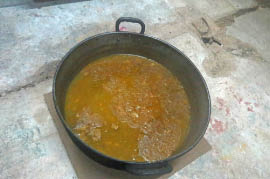
Party at Barrio El Carmen |

Party at Barrio El Carmen |
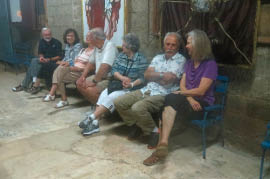
Party at Barrio El Carmen |

Party at Barrio El Carmen |
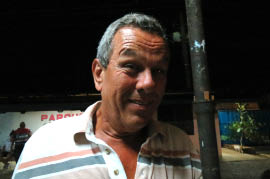
Party at Barrio El Carmen |
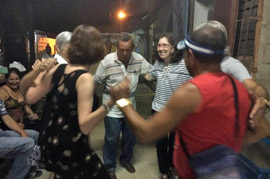
Party at Barrio El Carmen |
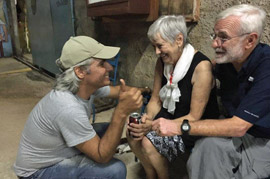
Party at Barrio El Carmen |

Party at Barrio El Carmen |
10/15/16 – Remedios to Matanzas, then Resort in Varadero
After breakfast, we climb on the bus and head east to our final destination of the day, Varadero, some 150 miles east, according to my rough calculations.
I take photos from the bus window to capture the “real” Cuba.

Pictures from the bus |

Pictures from the bus |
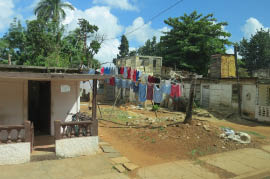
Pictures from the bus |

Pictures from the bus |
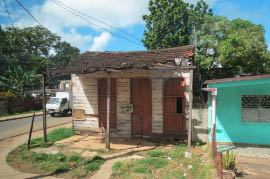
Pictures from the bus |
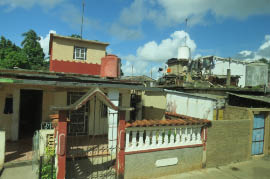
Pictures from the bus |
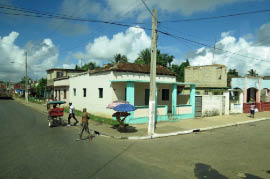
Pictures from the bus |
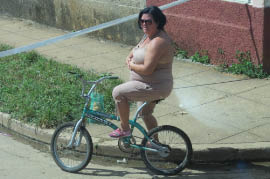
Pictures from the bus |

Pictures from the bus |
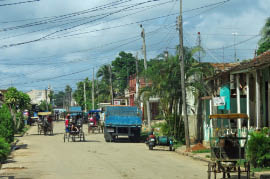
Pictures from the bus |
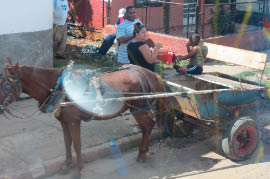
Pictures from the bus |
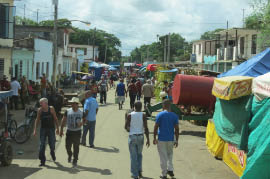
Pictures from the bus |
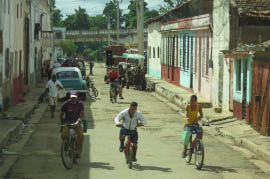
Pictures from the bus |

Pictures from the bus |

Pictures from the bus |

Pictures from the bus |

Pictures from the bus |

Pictures from the bus |
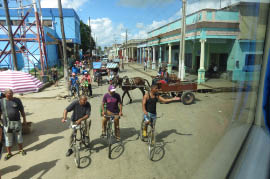
Pictures from the bus |
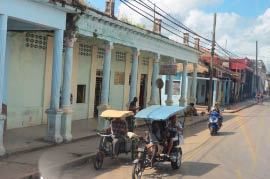
Pictures from the bus |
We make a lunch stop in Jovellanos at Finca Luna, a wonderful oasis owned and operated by a very talented, hardworking extended family. Some the family members greet us with Latin music that always puts a happy, relaxed spell over us.
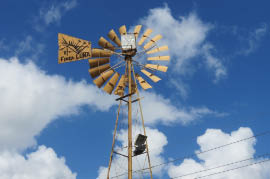 Finca Luna Finca Luna |
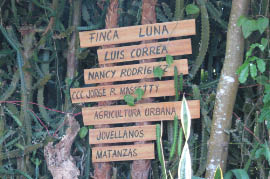 Finca Luna Finca Luna |

Finca Luna |

Finca Luna |
We have a welcome drink and meet the family. “Luna” is a combination of the names Luis and Nancy. They are a married couple and talented potters. They, along with family members, created this wonderful place. It’s mind boggling what they do here –
- farm the land,
- run a local nursery,
- operate an organic restaurant,
- make pottery and other funky art,
- raise roosters (and peacocks)
They also involve the community. Senior citizens come here to take classes – producing plays, making ceramics, and tutoring young students.
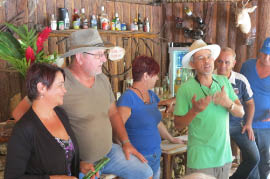 Finca Luna Finca Luna |
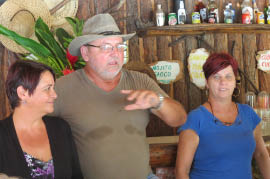 Finca Luna Finca Luna |
Everything is so beautiful and pristine. We enjoy hanging out by the pool listening to music and chasing the peacocks.
 Finca Luna Finca Luna |
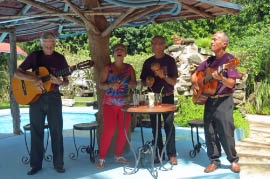 Finca Luna Finca Luna |

Finca Luna |
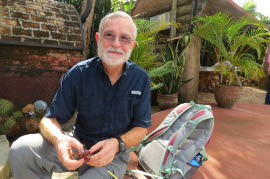
Finca Luna |
Before lunch, a relative of the family guides us around the farm dotted with fun crazy sculptures. We learn about growing coffee and other produce – bananas, avocados and cashews (the only fruit with their seed growing outside flower). We also learn about a wild and wicked cactus that makes you sick if you even just brush up against it.
We visit the “mini zoo” and see a hawk and a creepy rat that has significance to Cuba – somebody help me out on this one. My photographic eye is drawn to the bright white sheets hanging out back. I go to capture the light and shadows only to find a vicious guard dog -- luckily the chain held!

F
inca Luna |

Finca Luna |
 Finca Luna Finca Luna |
 Finca Luna Finca Luna |

Finca Luna |
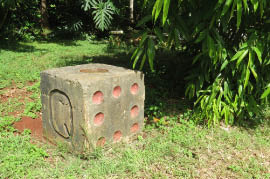
Finca Luna |
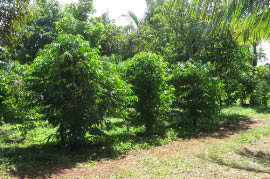
Finca Luna |

Finca Luna |
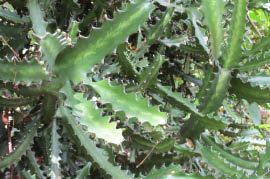
Finca Luna |
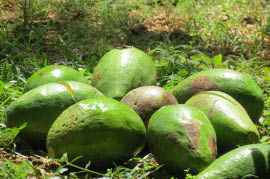
Finca Luna |
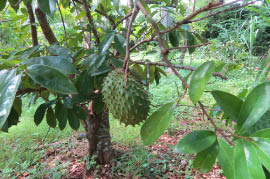
Finca Luna |

Finca Luna |
After the tour we help ourselves to a fantastic buffet style lunch. Life is oh so good. Fat and happy, we hit the road again.
Before I know it we are in Matanzas, the "Athens of Cuba." Maybe I slept through the part about the town’s many poets, writers, artists and musicians. All I know is that we are dropped off at a baseball field, a modest one at that. However, its claim to fame is that it is the oldest continually used baseball diamond in the Western Hemisphere – Palmar de Junco.
In the mid-1800's American sailors visiting Cuba on cargo ships taught the locals how to play baseball. Rich Cuban kids who went to schools in the US, returned home ready to play ball. The first official game between Matanzas and Havana was in 1874.
We sit in the stands and talk with Rigoberto Rosique a local ball player and member of the Cuban Hall of Fame. He was a famous outfielder who hit .323 for Cuba in the 1970 Amateur World Series -- which they won.
Rigoberto now operates a government-sponsored baseball academy here for promising young players. Raul tells us that all Cuban professional players have another paid profession, but they actually spend most of their time on baseball.
The passionate baseball fans in our group treasure the time at this baseball stadium talking to one of the greats. Bill (Judy’s Bill) is a real fan and knows a lot. He presents Rigoberto with our gifts from the U.S.
Not being a baseball fan, but a baseball player (first baseman – oops first baseperson -- on my church team), I long to get out on the field. After Raul announces, “Time for one more question,” I immediately reply “Can I get out there on the field and run round the bases?” Thank you Rigoberto, great baseball player, for opening the gate – making me feel like I was back in 7th grade on the old ball field.
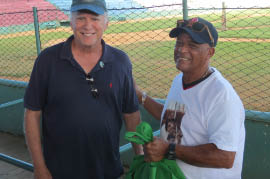 Bill Harrington and Rigoberto Rosique Bill Harrington and Rigoberto Rosique |
 Rigoberto Rosique Rigoberto Rosique |

Nancy rounding first |
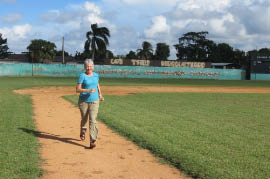
Nancy coming home |
We arrive at the Melia Las Americas Hotel Resort about 6 pm in the nearby town of Varadero. It is a Miami Beach-type getaway peninsula that non-U.S. citizens have been visiting for years. The resort is all inclusive – drinks and food – all free (rather all pre-paid). The place is quite luxurious. Our room (actually 2 rooms) was huge overlooking a series of artfully sculptured swimming pools with a gorgeous beach just a few steps beyond.
Bill and Judy head for the beach and a dip in one of the many pools. My Bill, and I, like fish out of water, don’t know how to relax. We attempt to get organized and try to book dining reservations at one of the three gourmet restaurants. The place is mobbed and the reservation counter is closed. With no reservations, we end up with some friends at the so-so all-you-can-eat buffet. These places depress me, but the chocolate ice cream is excellent – almost makes up for it.
Thank goodness we are only staying here one night – Resorts make us crazy. Give us the real Cuba.
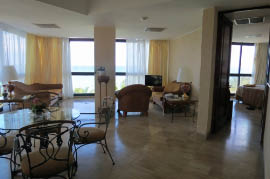 Melia Las Americas Hotel Resort Melia Las Americas Hotel Resort |
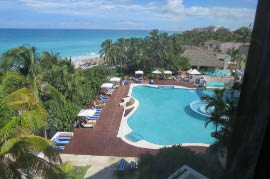 Melia Las Americas Hotel Resort Melia Las Americas Hotel Resort |

Melia Las Americas Hotel Resort |

Melia Las Americas Hotel Resort |
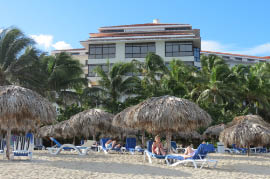
Melia Las Americas Hotel Resort |
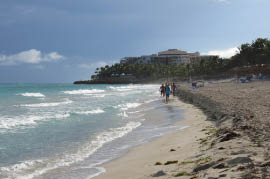
Melia Las Americas Hotel Resort |
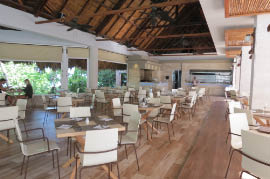
Melia Las Americas Hotel Resort |

Melia Las Americas Hotel Resort |

Melia Las Americas Hotel Resort |
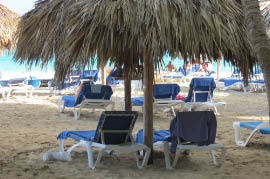
Melia Las Americas Hotel Resort |
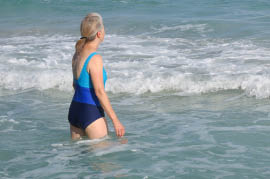
Melia Las Americas Hotel Resort |

Melia Las Americas Hotel Resort |
10/16/16 – to Havana
After roaming through miles of breakfast buffet tables, I find a little cereal that reminds me of home. We have the rest of the morning “to enjoy on our own at the resort.” Patty and I decide to explore the grounds and then walk to a nearby shopping center.
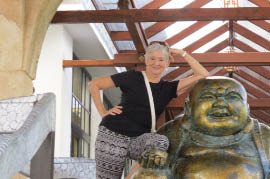 Melia Las Americas Hotel Resort Melia Las Americas Hotel Resort |
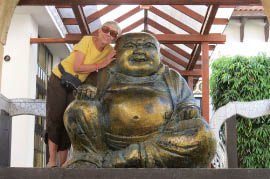 Melia Las Americas Hotel Resort Melia Las Americas Hotel Resort |

Melia Las Americas Hotel Resort |
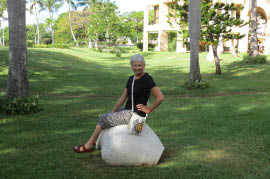
Melia Las Americas Hotel Resort |
We meet some of the hotel staff. Fun gals – Cubans are always ready for a party. We notice strange curly-tailed lizards that look like rabbits when they run.
The shopping center was too Americanized for us. One funny thing happened. Patti was standing outside the Women’s Restroom waiting for me. A Cuban, thinking Patti worked at the restrooms, gave her a few “CUCs” for some toilet paper. We have a good laugh about that one.
 Melia Las Americas Hotel Resort Melia Las Americas Hotel Resort |
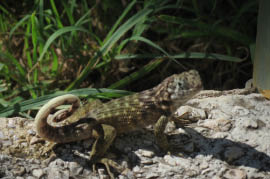
Melia Las Americas Hotel Resort |
We come back to the hotel for an early light lunch and then board the bus for Havanan (with a few stops in between).
We stop in Matanzas to learn about Regla de Ocha, an African-based religion better known as Santería. (Misinformed Americans, including myself call it Black Voodoo.)
We meet a local practitioner who is a kind and gentle woman. She tells us that the spiritual leaders are all devout Catholics and use Santería on the side to help others. A young couple from Japan happened to be at the house that day. They came to Cuba to find a cure for the woman’s serious health issue, and found a miracle. Now they are true believers.
After our talk, we explore the house. I am intrigued by the many strange altars. Saint Lazarus plays a prominent role. Story goes that 4 days after his death, Jesus restored him to life. Dogs are depicted with Lazarus in pictures and statues because the story goes that the dogs on the street licked his blood while he was dead for those 4 days. Other strange altars and idols blended from Christian and African, were also in the house. Although there’s some serious weirdness going on, the house is filled with love and happiness. Maybe I want to try some of that!
A side note from Raul:
Ricky Recardo's song "Babalu" is the name of a Santería "superior priest." No one in Cuba either knows of the song or of Desi Arnez. The Arnaz's family fled to the US after the 1930 revolution. Desi was a teenager at the time so he's a Cuban American, not really Cuban to other Cubans.
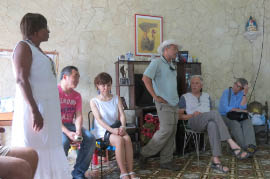 Santería House Santería House |
 Santería House Santería House |
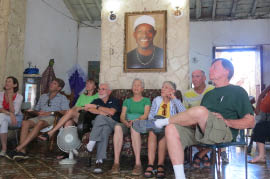 Santería House Santería House |
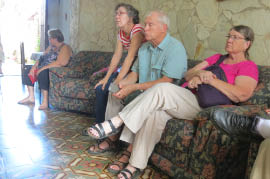 Santería House Santería House |
 Santería House Santería House |
 Santería House Santería House |
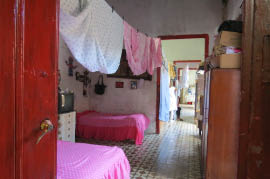 Santería House Santería House |
 Santería House Santería House |
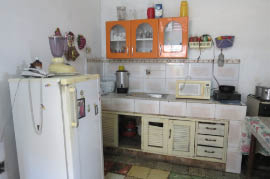 Santería House Santería House |
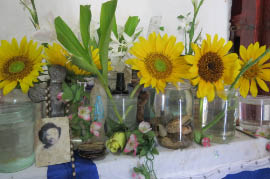 Santería Houset Santería Houset |
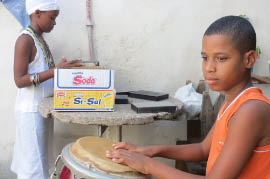 Santería House Santería House |
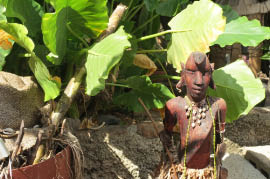 Santería House Santería House |
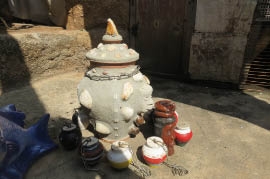 Santería House Santería House |
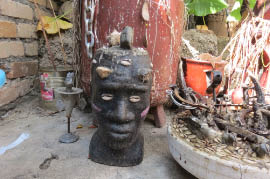 Santería House Santería House |

Lazarus |

Lazarus – Look for the Dog |

Santería House |
We leave Matanzas for Havana! We make a quick potty / souvenir stop. Judy and I both get earrings. Out back is an overlook of the “Puente Bacunayague,” an amazing feat of civil engineering spanning the valley with a beautiful pristine forest below. After traveling through miles of limited roads in the Cuban countryside, it’s a surprise to see such a modern freeway expanse.
 Good bye Matanzas Good bye Matanzas |
 Puente Bacunayague Puente Bacunayague |
We arrive in Havana, once called “Paris of the Caribbean.” Without modernization that occurred in most of the mid-20th century, Cuba was left untouched. The revolutionary government neglected the city and in doing so, saved Cuba from the wrecking balls. Havana was declared a UNESCO World Heritage site in 1982 – and now the work of saving the old buildings and facades has begun. I am very excited and start snapping pictures through the bus windows. Can’t believe I’m here!
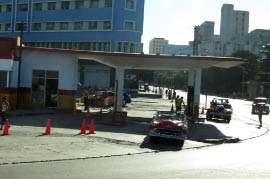 Hello Havana Hello Havana |
 Hello Havana Hello Havana |
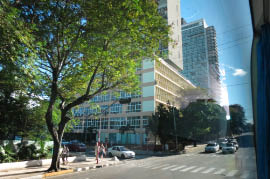 Hello Havana Hello Havana |
 Hello Havana Hello Havana |
 Hello Havana Hello Havana |
 Hello Havana Hello Havana |
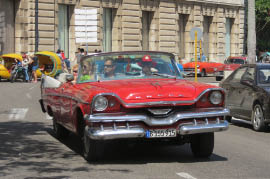 Hello Havana Hello Havana |
 Hello Havana Hello Havana |
We arrive at our hotel – Hotel Nacional opened in 1930. It’s a splendid place perched on a rocky outcrop overlooking the Malecón (famous seawall along the main drive that has protected the city for over a century).
We drive up a long, palm-lined entrance to the hotel and enter the stately marble columned lobby. The hotel is a true legend and immediately stirs up the ghosts of its past. Frank Sinatra and Nat King Cole are chatting over mojitos. Meyer Lansky is conducting a big Mafia meeting under the guise of seeing Frank Sinatra perform. The rich and the famous along with Hollywood screen idols are dancing the night away.
After the fall of Batista, the hotel took on a more somber vibe. During the 1962 Cuban missile crisis, Castro and Guevara, along with a small army, hid out in a bunker on the grounds.
Raul gives us our room keys and cautions us that the place is government run and don’t be surprised if there are stains on the carpet and the toilet doesn’t work.
In spite of the warning, I loved every part of the place – the old elevators, the marbled hallways, the heavy doors, etc.
After we unpack, we hook up with Bill and Judy for a stroll around the grounds and our welcome mojito drink. Beautiful gardens and eye popping views, this is the place!
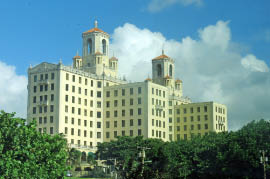 National Hotel National Hotel |
 View from the National Hotel View from the National Hotel |
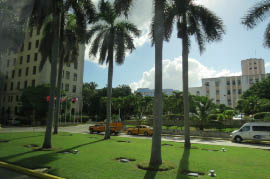 National Hotel National Hotel |
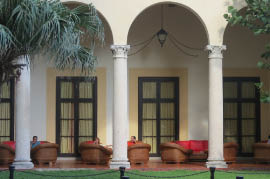 National Hotel National Hotel |
We take the bus to El Mar, a lovely paladar on Havana Bay. There was some miscommunication about our reservation and it takes a very long time to arrange tables and seat us. Then it took more time to deliver drinks (badly needed by then). The starters finally came. They were worth waiting for because they were the best food I’ve tasted in all of Cuba. For dinner, I order the lobster – big, lovely piece, but overcooked (guess that’s how they do it here.) The rains came with the main dish. We decided to “weather it” and try to finish dinner. We finally finish – a long, long night . (Raul is not happy with our service!)
We return to our room about 10 and find we have a problem with the electrical connections and getting the air conditioner to work. The housekeeper comes to our room a couple of times to wiggle a chord here and there and turn a switch on and off. Finally something worked. I really liked the housekeeper and her happy style and friendly warm hugs. It is clear that she had not received proper training in customer service, as we know it in the U.S. She even insisted on tucking me into bed. Never had that happen before, not even as a child, but it was a very sweet touch.
10/17/16 – Havana
After breakfast on the exclusive 8th floor, we board the bus. Our first stop is John Lennon Park. Cuba banned The Beatles’ music until the mid-sixties and it wasn't openly played on radio until1971. Eventually Fidel himself became a big fan and unveiled the statue of Lennon on December, 2000 -- the 20th anniversary of his assassination. (A couple months earlier, we were in New York’s Strawberry Fields, part of Central Park where pilgrims come to honor Lennon. I’m feeling very connected to the man and his extraordinary music.)
An extra pair of John Lennon-type glasses were left next to the statue so visitors could borrow them for that cool photo with Lennon. However, people kept stealing them so now the government pays an elderly man to stand by the statue, loaning the glasses for the silly poses. We have fun with John – I love my travel mates.
 Snuggling with John Lennon Snuggling with John Lennon |
 Snuggling with John Lennon Snuggling with John Lennon |
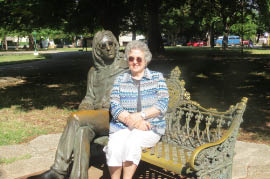 Snuggling with John Lennon Snuggling with John Lennon |
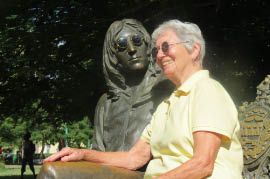 Snuggling with John Lennon Snuggling with John Lennon |
 Snuggling with John Lennon Snuggling with John Lennon |
 Snuggling with John Lennon Snuggling with John Lennon |
 Snuggling with John Lennon Snuggling with John Lennon |
 Snuggling with John Lennon Snuggling with John Lennon |

Snuggling with John Lennon |
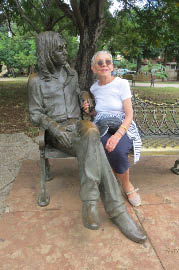
Snuggling with John Lennon |
We get a peek at the nearby neighborhood. Havana has lots of very run down, beautiful old mansions. Some that housed one rich family now house 12 or more people. There is virtually no homelessness in Cuba, but conditions may be very poor.
Bill is happy posing by an old classic car in the old classic hood.
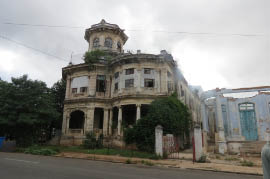 Old mansion Old mansion |
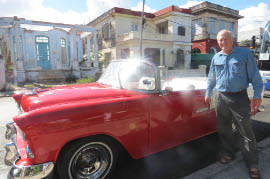 Old Bill and Old Car Old Bill and Old Car |
Next stop is the Malpaso dance company, one of the few private dance companies in Cuba. Everywhere in Cuba, the arts are revered. The dancers are professionals and travel to many countries to perform. They will be in L.A. in November 2017.
We watch the dancers stretch and warm up. Then they perform an impressive mini-recital followed by a long discussion with the dance troupe. They give it their all – inspiring!
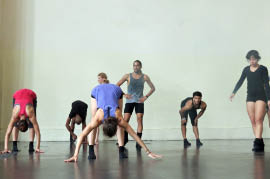 Malpaso dance company Malpaso dance company |
 Malpaso dance company Malpaso dance company |
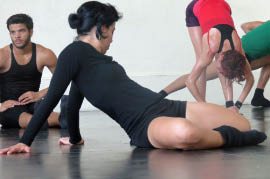 Malpaso dance company Malpaso dance company |
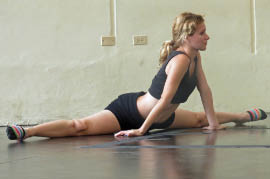 Malpaso dance company Malpaso dance company |
 Malpaso dance company Malpaso dance company |
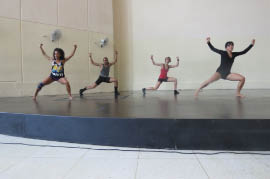 Malpaso dance company Malpaso dance company |
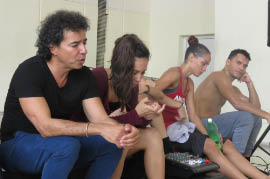 Malpaso dance company Malpaso dance company |
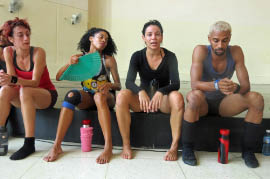 Malpaso dance company Malpaso dance company |
 Malpaso dance company Malpaso dance company |
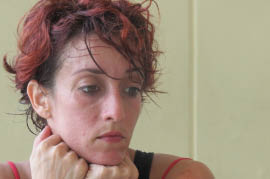 Malpaso dance company Malpaso dance company |
The dance company’s rents studio space in an old building that is a Jewish Memorial Center (Centro Hebreo Sefaradi de Cuba). After the dance recital, I checked out some of the museum displays and find one particularly poignant, very applicable for today, given our new situation.
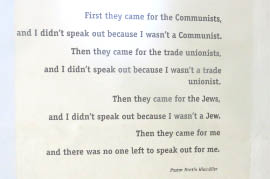 Jewish Memorial Center Jewish Memorial Center |
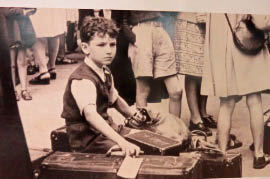 Jewish Memorial Center Jewish Memorial Center |
Next stop is at Club Melen, a private restaurant located in the Miramar section of Havana. Club Melen is the hang out for the local Domino Champs. Several of them are there to share their knowledge of the game. I like these guys – they remind me of my engineer pals back home.
We have a nice lunch and then partner up to play dominoes for a couple of hours. Bill and I lose to Barbara and Beth, but just barely. It’s a lovely way to spend an afternoon
 Club Melen Club Melen |
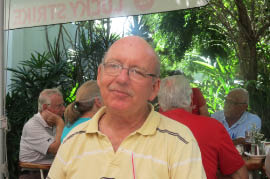 Club Melen Club Melen |
 Dominos at Club Melen Dominos at Club Melen |
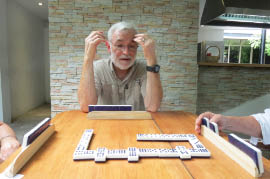 Dominos at Club Melen Dominos at Club Melen |
 Dominos at Club Melen Dominos at Club Melen |
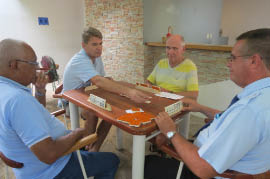 Dominos at Club Melen Dominos at Club Melen |
We return to the hotel to learn about the current Cuban jazz movement from the William Roblejo’s Trio. They make some exciting sounds – especially the leader with half of a violin.
Jim, member of our travel group and a retired music teacher, was almost brought to tears when he told us that he has been involved in music for over 50 years and this trio is the most exciting group he has ever heard … but bare in mind, he hasn’t heard my granddaughter and her jazz band!
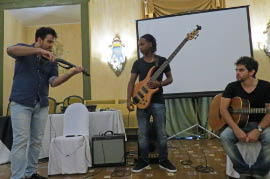 William Roblejo’s Trio William Roblejo’s Trio |
 William Roblejo’s Trio William Roblejo’s Trio |
 William Roblejo’s Trio William Roblejo’s Trio |
 William Roblejo’s Trio William Roblejo’s Trio |
We dine at La Moraleja, another paladar in a nearby neighborhood. It is in a cellar with a man cave’s feel. Dinner was fine. Serving each of us a Cuban cigar to go with our coffee was really cool. I give my cigar to the bus driver. He seemed pleased.
10/18/16 – Havana
After breakfast at the hotel, we meet in the conference room to hear a lecture on Cuban Music by David Faya – a professor, researcher and award-winning musician. His presentation was funny, engaging, and enlightening. I learn so much about how music results from the exposure to new cultures. With sound, he guides us through the blending of rhythms and melodies from medieval times to the present. I was riveted. Now if I could remember only 20% of what he said, that would be great.
 David Faya David Faya |
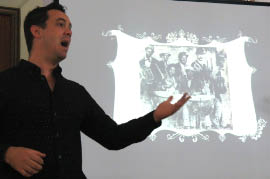 David Faya David Faya |
Next we drive to the historical Spanish fortress La Cabana (Castillo del Morro) built on the cliffs at the entrance to the Bay of Havana. It is one of a number of fortresses constructed to protect the city since 1589.
We walk through the massive fort and stop to see twenty some odd historic canons lined up along the fortress walls.
 Castillo del Morro Castillo del Morro |
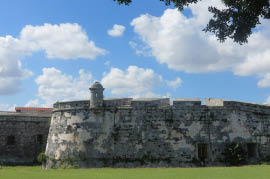 Castillo del Morro Castillo del Morro |
 Castillo del Morro Castillo del Morro |
 Castillo del Morro Castillo del Morro |
 Castillo del Morro Castillo del Morro |
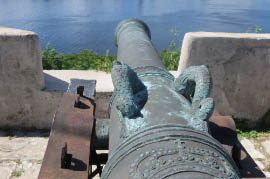 Castillo del Morro Castillo del Morro |
Raul fills our heads with facts about the canons left over from bygone centuries – their markings, where they were built, what combat action they saw, etc. However, I am drawn to amazing views of Old Havana’s directly across the bay.
 View of Old Havana View of Old Havana |
 View of Old Havana View of Old Havana |
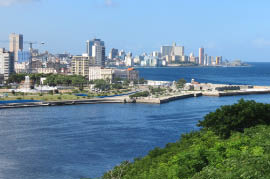 View of Old Havana View of Old Havana |
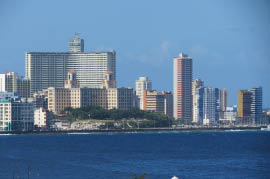 View of Havana View of Havana |
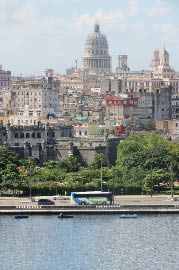
View of Old Havana |

View of Old Havana |
We have about 30 minutes to do the fortress on our own. I could have spent hours there, especially with my extremely bad sense of direction. Something about the place triggers my overactive imagination. The clock has turned back and I am a prisoner awaiting execution. I see a tucked-away corner where actual firing squads lined up their victims – just a quiet little discreet place used often in Cuba’s violent history.
 Castillo del Morro Castillo del Morro |
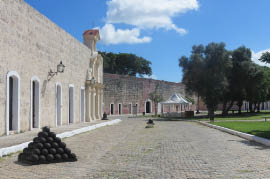 Castillo del Morro Castillo del Morro |
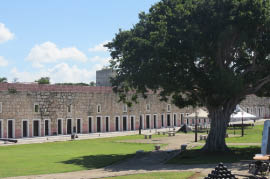 Castillo del Morro Castillo del Morro |
 Castillo del Morro Castillo del Morro |
 Castillo del Morro Castillo del Morro |
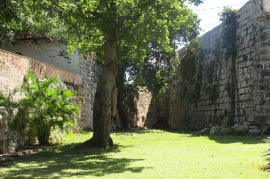 Castillo del Morro Castillo del Morro |
I am drawn to Che Guevara headquarters housed in the old fort. He was here often after the Revolution in 1959. Don’t know why I find Che a charismatic leader. He was here to do “clean up” work, a main task to help Castro rid the new country of leftover Batista supporters -- a fairly easy task without courts and trials and “due process” in place.

Che Cuevara headquarters |

Che Cuevara headquarters |
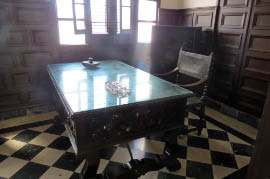 Che Cuevara headquarters Che Cuevara headquarters |
 Che Cuevara headquarters Che Cuevara headquarters |
Our last stop at the fort is, of course, the gift shop. A couple of the El Morro fortress rooms are set aside for souvenir shops. They still have a long way to go in figuring out capitalism – but our Cuban friends are making progress, especially in the cigar shop. They have a couple of marketing draws aside from a decent selection of t-shirts.
- A figure of renowned Cuban cigar roller, Jose Castelar Cayro (Cueto), that could be in a Madam Tussaud museum. He looked so real that I approach him (it) gingerly;
- The longest cigar in the world – almost the length of a football field, rolled by Cueto; and
- Decent cigars for sale, highly recommended by Raul. (My son-in-law was pleased with the selection of cigars we brought back for him. He was growing weary of getting t-shirts that are always too small.)

Che Cuevara headquarters |

Jose Castelar Cayro (Cueto)
Looks real to me |
 Longest cigar in the world Longest cigar in the world |
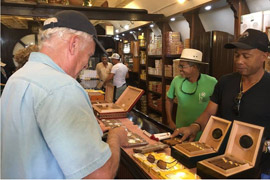 Bill buying cigars Bill buying cigars |
 Putin likes cigars, too Putin likes cigars, too |
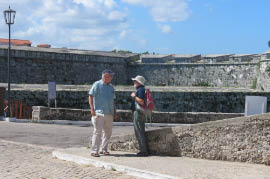 Bill and Bill Bill and Bill |
We leave the fort for Old Havana to have lunch at Paladar Le Figaro. The friendly host greets us at the door and takes us upstairs. We are seated in a room where the walls are covered with graffiti left by artsy patrons. The food has an Italian flair and the place could easily compete with the finest of cafés in San Francisco. BRAVO!
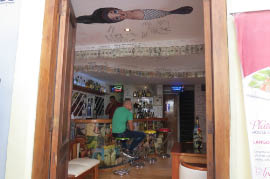
Paladar Le Figaro |
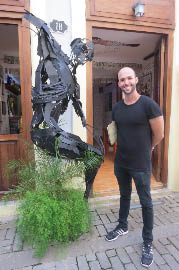
Paladar Le Figaro |
After lunch, we go outside to explore the classy little side street. We are amazed to learn that only a few years ago, this street was crumbling and dirty like the rest of Old Havana.
Without urban renewal funds, the neighbors came together to clean it up. The spark that ignited the renewal was Gilberto Valladares, nicknamed Papito. He was born in Havana in 1969 and went to trade school to become a barber. Paptio bought a rundown 18th century house on the block and made it his hair dressing salon and the first Hairdressing Museum in Cuba (or anywhere, for that matter).
His hair styling business planted a seed for the community. The project, Arte Corte (Cutting Art), in Old Havana, has won several international awards. Since 2002, Papito’s cultural project, which gained the support of the City Historian’s Office, has brought together barbers, hairdressers, models, artists and historians to preserve this area. With very little funds, a lot of hard work and talent, the block is alive with restaurants, bars, art studios, a local playground, and training schools for students in culinary and hair design.
The neighbors come together to clean the streets, install artsy signs, and support the local businesses. There neighborhood is now a jewel in Old Havana and other communities are following suite.
With the opening up of Cuba and the beginning of a growing tourism industry, run down neighborhoods in Old Havana (like Arte Corte) are springing to life. Raul told us in the last 18 months, more than 900 restaurants (paladars) have opened in Old Havana.
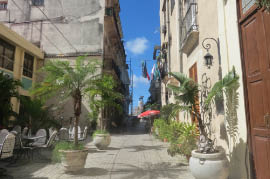 Old Havana Old Havana |
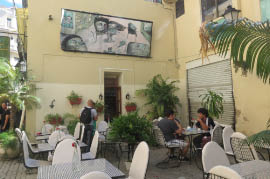 Old Havana Old Havana |
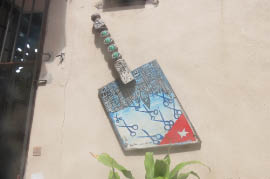 Old Havana Old Havana |
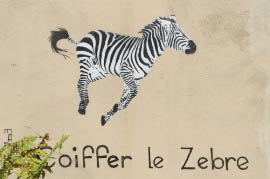 Old Havana Old Havana |

Old Havana |

Old Havana |
We visit Papito’s salon in the old 18th century mansion and see him at work. The salon is not only a place to get your hair-do, but to see a museum packed with antique scissors, razors, mirrors, vials, shaving brushes, combs, and brushes, along with original paintings and drawings by Cuban artists, all focusing on the topic of hairdressing. Only a passionate Cuban could make hairdressing a wild and crazy place
 Old Havana Old Havana |
 Old Havana Old Havana |
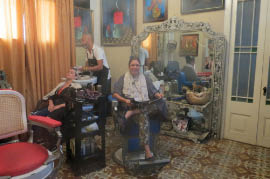 Old Havana Old Havana |
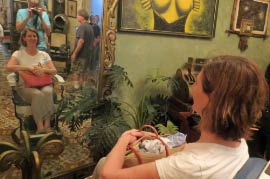 Old Havana Old Havana |
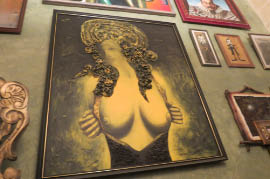 Old Havana Old Havana |
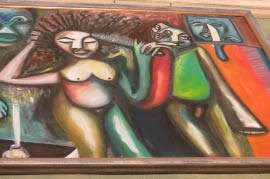 Old Havana Old Havana |
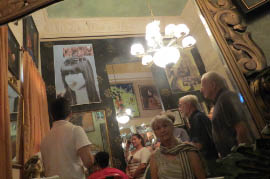 Old Havana Old Havana |
 Nancy in Old Havana Nancy in Old Havana |
We continue our stroll down the streets of this wonderful neighborhood, stopping at a beauty school where new hairdressers are trained and some unique art galleries.

Old Havana |
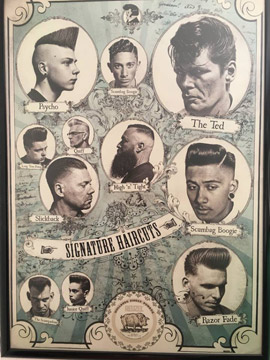
Old Havana |
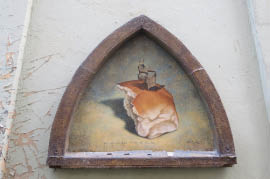 Old Havana Old Havana |
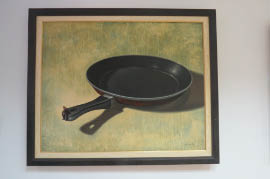 Old Havana Old Havana |
 Old Havana Old Havana |
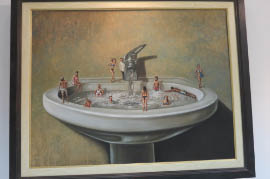 Old Havana Old Havana |
The rest of the group takes the bus back to the hotel. The 2 Bills, Judy and I decide to wander around on our own. Judy and I are hot to shop while our Bills are hot to dash down the street (and save their bills – he he). Judy and I did not find many interesting galleries / shops in the crumbling, raw sections of Cuba and we are frustrated trying to see it all while dashing after our spouses. Oh the wows of long term marriages! I try to snap a few photos of the old city. In any case, it is great fun to be exploring on our own.
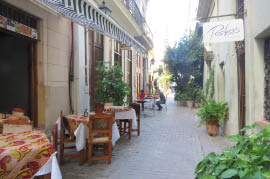 Streets of Havana Streets of Havana |
 Streets of Havana Streets of Havana |
 Streets of Havana Streets of Havana |
 Streets of Havana Streets of Havana |
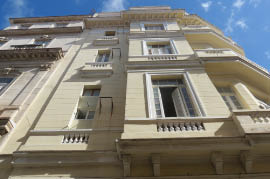 Streets of Havana Streets of Havana |
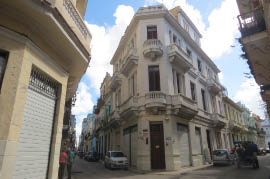 Streets of Havana Streets of Havana |
 Streets of Havana Streets of Havana |
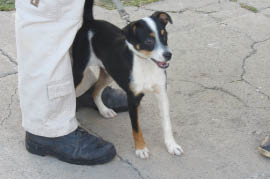 Streets of Havana Streets of Havana |
 Streets of Havana Streets of Havana |
 Streets of Havana Streets of Havana |
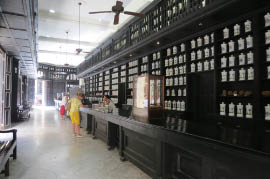 Streets of Havana Streets of Havana |
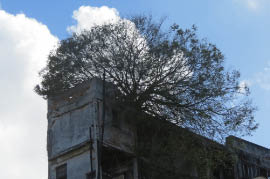 Streets of Havana Streets of Havana |
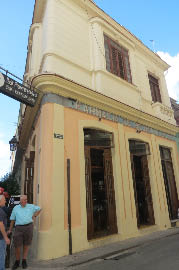
Streets of Havana |

Streets of Havana |

Streets of Havana |
We finally catch up with our hubbies at La Florida, one of Hemingway’s haunts made famous in his novel, “Islands in the Stream.” In the 1950’s, the Hollywood crowd – Errol Flynn, Frank Sinatra, Ava Gardner, Gary Cooper and Marlene Dietrich – were all regulars here.
We go in for a beer only to discover the place is packed and the band is so loud we can’t think -- so we hit the street again in search of another watering hole.
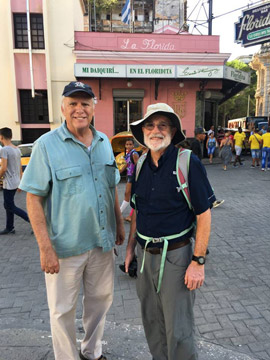
Streets of Havana |
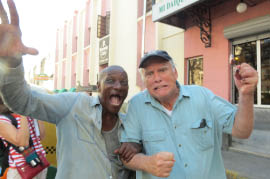 Old Havana Old Havana |
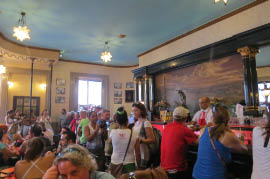 Old Havana Old Havana |
Finally, the four of us grumpy, weary travelers in need of a beer, come to Parque Central under the statue of Jose Marti (freed Cuba from the Spain). Judy studies the map while our spouses continue on with their own conversations. I spot an old hotel right across the street (Hotel Inglaterra) with an outdoor café and an inticing band. Perfect for cervesa – a round of Bucanero for all of us!

Parque Central |
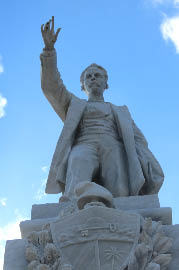
Jose Marti |
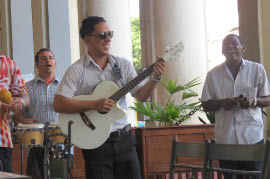 Time for a Bucanero Time for a Bucanero |
 Time for a Bucanero Time for a Bucanero |
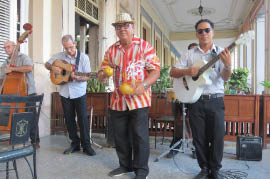 Time for a Bucanero Time for a Bucanero |
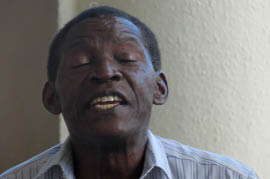 He could use a Bucanero, too He could use a Bucanero, too |
Refreshed, we think about walking down the Prado historic promenade lined with trees and statues that leads directly to the Malecon (old seawall) and then take a left to our hotel … but we think better and grab a taxi.
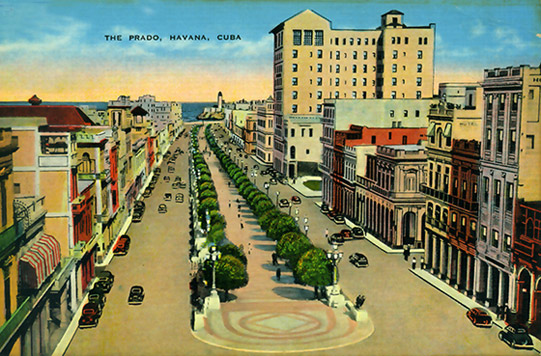
Prado |
Back at the hotel we shower and get ready for the evening. Later, we join Bill and Judy and walk a few blocks from the hotel and find a great little place for dinner. Some passers-by on the street tried to talk us into going to another place – glad we didn’t listen to them. We find fellow-traveler Susan at the table next to us writing in her journal. She tried to talk us into getting the flan – sorry we didn’t.
It’s about 10 when we get back to the hotel. The place is buzzing with life -- rocking and rolling with music and sexy dancers. The mood is young and exciting … but we are not, so we head up to our room for beddy-bye time.
10/19/16--Havana
After breakfast, Jorge Mario, a brilliant Cuban economist who lives in Havana, gave a powerful powerpoint presentation. He gave us the real inside track of the rocky relationships in trade between U.S. and Cuba and how impossible it is to unravel all the congressional bills in place designed to keep the embargo. We are disappointed when the powerpoint presentation crashes – but like a champ, Jorge carries on. (Grand Circle does a fantastic job lining up experts who know their stuff.)
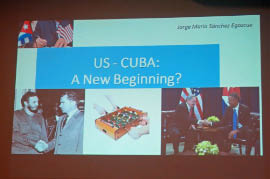 Jorge Mario Presentation Jorge Mario Presentation |
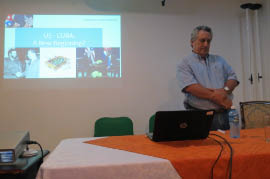 Jorge Mario Presentation Jorge Mario Presentation |
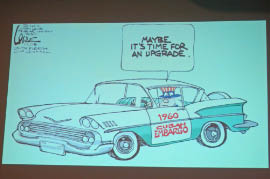 Jorge Mario Presentation Jorge Mario Presentation |
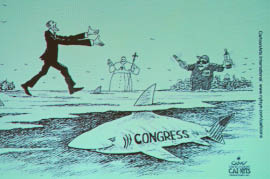 Jorge Mario Presentation Jorge Mario Presentation |
Next on the morning’s agenda is a walk through the streets of Old Havana – where the city was founded in August 1514 by the Spanish Conquistador Diego Velázquez de Cuéllar. The first Spanish settlers built their homes right here in what is now a UNESCO World Heritage site. Lots of brightly dressed gals -- some carrying flowers, some even smoking cigars -- roam the area hoping to be part of your phot op – for a fee, of course.
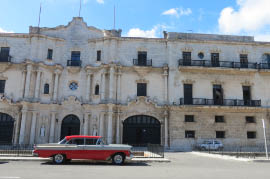 Old Havana Old Havana |
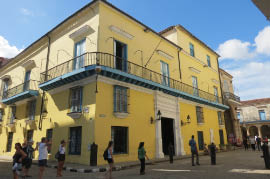 Old Havana Old Havana |
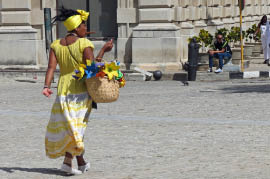
Old Havana |
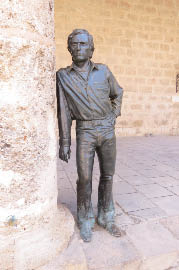
Old Havana |
A turn or two on side streets and we find ourselves in Plaza de la Cathedral. In the 16th Century, it was named “Little Swamp Square,” a seedy place where the city’s rainwater drained. Next the square became the site of a fish market. Construction began in the 18th Century, making it the last square to be built in Old Havana.
Havana Cathedral, completed in 1777, dominates the square. I spend some time in this stunning Baroque cathedral – fascinated by paintings with a 3-D elements thrown in. Although I’m not Catholic, I am always intrigued by the cozy wooden confessionals – stirs the imagination about what is said and all that judging going on.
By the way, as we are leaving cathedral, I am surprised to see a bride and groom. Raul tells us that there's not a lot of formal marriage in Cuba. People just live together, but unlike in the states, they still call their mate "wife" or "husband. The divorce rate was once very high – about 70%, then people stopped getting married and it plummeted to fewer than 10%.
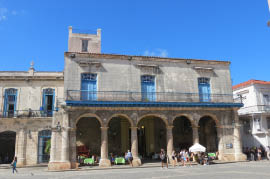
Plaza de la Cathedral |

Plaza de la Cathedral |

Plaza de la Cathedral |
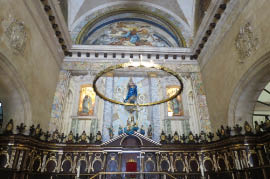
Plaza de la Cathedral |
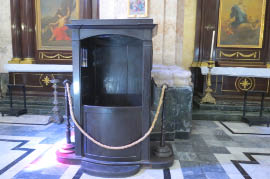
Plaza de la Cathedral |
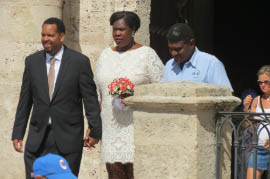
Plaza de la Cathedral |

Plaza de la Cathedral |

Plaza de la Cathedral |
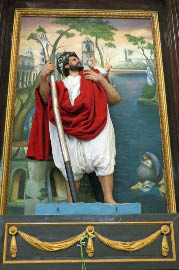
Havana Cathedral |
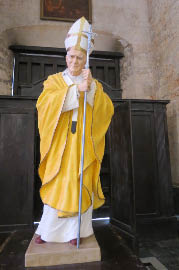
Havana Cathedral |
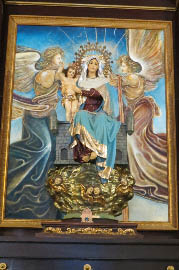
Havana Cathedral |
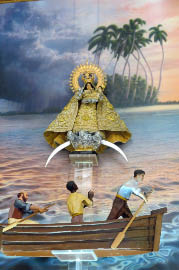
Havana Cathedral |

Havana Cathedral |
Most of the old buildings scattered around the squares and side streets were once the mansions of rich slave owners, merchants, heads of government officials, heads of military, etc. A lot of the mansions morphed into classy restaurants and clubs, museums, galleries and of course, touristy shops.
Raul shows us one mansion, owned by a wealthy slave owner. The outside wall is covered by a huge mural depicting 19th century life of the rich and famous aristocrats. (Check out the last photo – Just what is that guy doing with his right hand?!)
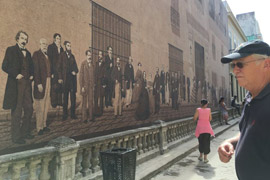
Old Havana |
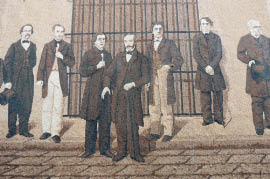
Old Havana |

Old Havana |
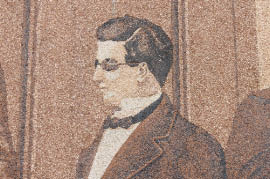
Old Havana |
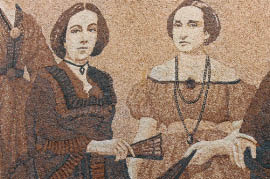
Old Havana |

Old Havana |
Tucked back off the busy streets is a pleasant park dedicated to the study of plants. The big nosed guy, below, established the center here and it is here that I learn that the bougainvillea, no matter how colorful they may be, only have tiny white flowers at the end of the vines. What we think are colored flowers are only the leaves.

Old Havana |
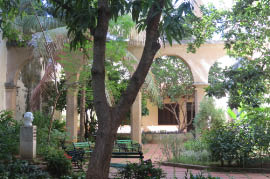
Old Havana |
Raul shows us how the city merges the old with the new applying architecture styles that are creative and clever. Raul also takes time for us to get a whiff of the sewer system to show us Cuba’s good, bad and ugly. Although Old Havana is charming, a lot of its infrastructure is badly in need of repair. Water is a problem all over the island.
By the way, 3 million people live in Havana. The amount of space per person is regulated. The government requires a permit for you to live here.

Old with the new |
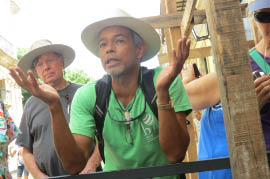
Get a Whiff of the Sewer |
We amble through more colorful side streets and glorious old squares. The former stock exchange building is in the Plaza de San Francisco. In front of it is a fascinating sculpture called “The Conversation,” by French artist Etienne, donated to the city in September 2012.
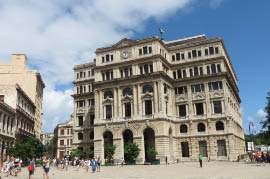
Old Stock Exchange Building |
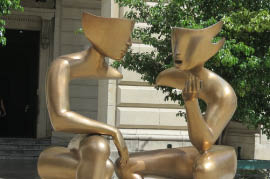
The Conversation |
Next we find ourselves in the Plaza de San Francisco de Asis with more old beautiful government buildings and a statue of Junipero Serra of California mission fame. Serra had never been in Cuba, the town's leaders used the statue as a tourist advertisement to entice more Spanish to come to Cuba. Born in Petra Mallorca in 1713, died in Carmel California in 1784, we’ve visited a lot of Serra’s stomping grounds. Now we’re visiting a place he has never been – oh the wicked ways of marketing!
The wide spacious square is lively with tourists along with a stilt walker and a father playing with his son.

Statue of Junipero Serra |

Statue of Junipero Serra |

Plaza de San Francisco de Asis |
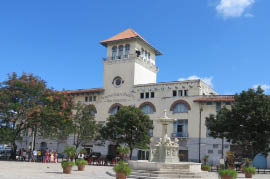
Plaza de San Francisco de Asis |

Plaza de San Francisco de Asis |
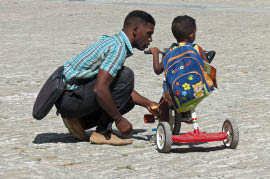
Plaza de San Francisco de Asis |
On the sidewalk in front of the Basilica is a life-sized statue of a former well-known Havana resident by the name of Jose Villa Soberon, who apparently lost his mind while in prison and then returned to walk the streets of Havana. Rub his beard and good luck will follow.
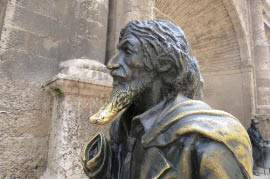
Jose Villa Soberon |
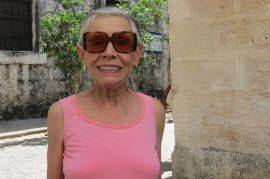
Patti |
Private entrepreneurship is just beginning to really take off. Raul introduces us to a guy selling beignets on the street. He makes as much as $600 a month selling beignets if he works 7 days a week. That is a lot more than his former job as a medical assistant in an artificial insemination practice. Young people apparently often make as little as $20 a month. We stop and chat with the guy and of course, buy a beignet.
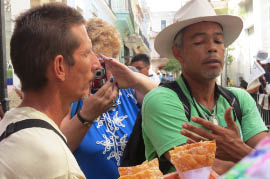
Beignet Vendor |
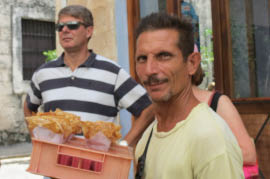
Beignet Vendor |
Plaza Vieja seems to be the square with the most interaction – and my favorite square of all.
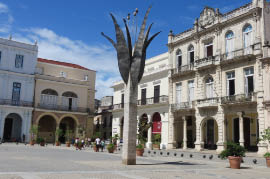
Plaza Vieja |

Plaza Vieja |
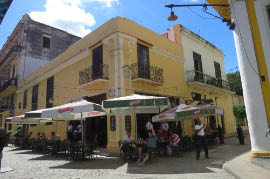
Plaza Vieja |

Plaza Vieja |

Plaza Vieja |

Plaza Vieja |
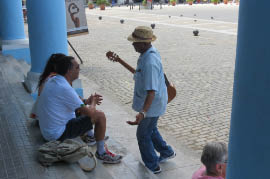
Plaza Vieja |
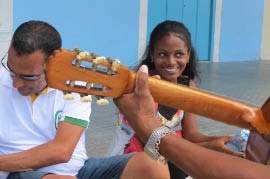
Plaza Vieja |
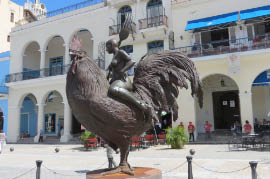
Plaza Vieja |

Plaza Vieja |

Plaza Vieja |
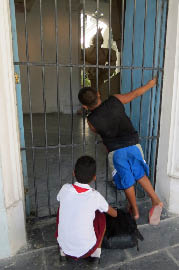
Plaza Vieja |
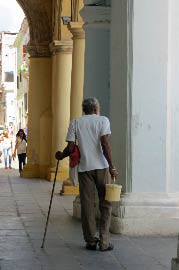
Plaza Vieja |
The bus heads back to the hotel. About 10 of us get off at Sloppy Joe’s for lunch. Sloppy Joe’s is another legendary Ernest Hemingway hang-out. It was very popular with U.S. tourists during the Prohibition years of 1920’s and 1930’s. Until the Revolution, it was visited by celebrities like Frank Sinatra, Ava Gardner, Nat King Cole, John Wayne, Spencer Tracy and Clark Gable.
Bill and I shared the Cuban Sandwich while the café TV played Debbie Reynolds, Gene Kelly, and Donald O'Connor dancing in the rain. Food was good – it’s a happy place!
.

Sloppy Joe's |

Sloppy Joe's |
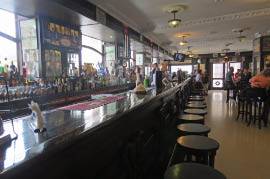
Sloppy Joe's |

Sloppy Joe's |
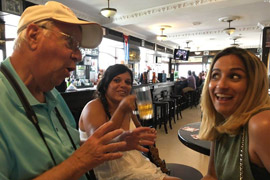
Sloppy Joe's |
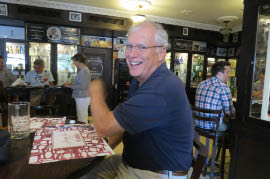
Sloppy Joe's |
Bill and I explore on our own. We stop at Mueso de Bellas Artes. We don’t have time to do this place justice, so we make it a quick pit stop and hit the street again.
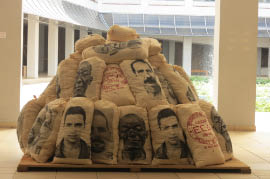
Mueso de Bellas Artes |
 Mueso de Bellas Artes Mueso de Bellas Artes |

Hit the Streets |
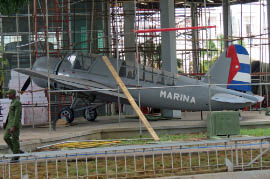
Interesting Display in the Square |
We bump into Bill and Judy again and amble down the Prado, taking a side street into the real Cuba. I have a grand time with my camera.
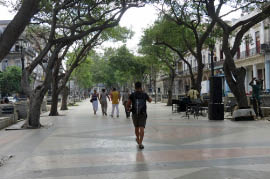
The Real Havana |
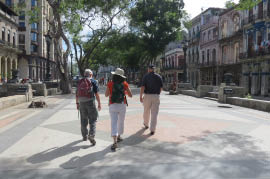
The Real Havana |
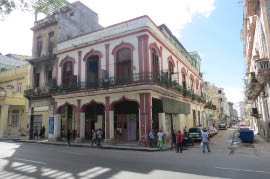
The Real Havana |

The Real Havana |
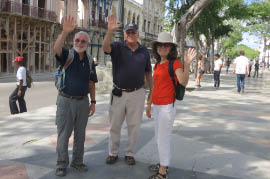
The Real Havana |
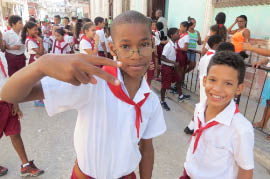
The Real Havana |
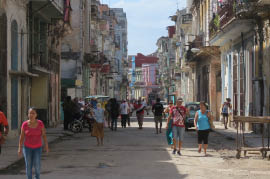
The Real Havana |
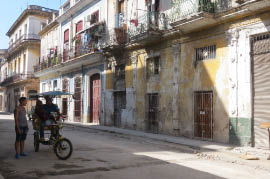
The Real Havana |

The Real Havana |
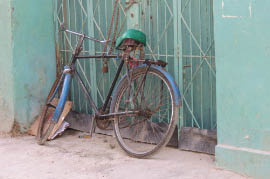
The Real Havana |
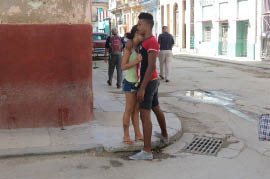
The Real Havana |
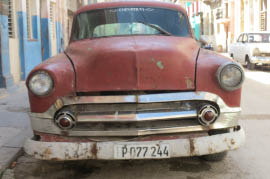
The Real Havana |

The Real Havana |

The Real Havana |
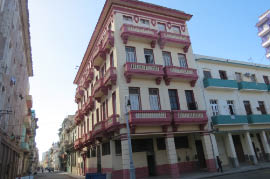
The Real Havana |

The Real Havana |
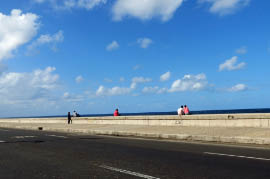
The Real Havana |
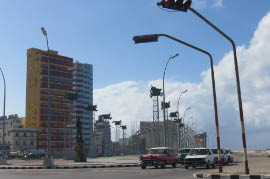
The Real Havana |

The Real Havana |
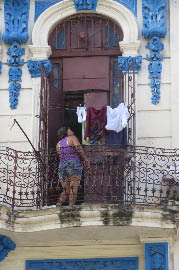
The Real Havana |

The Real Havana |
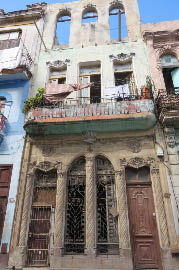
The Real Havana |

The Real Havana |
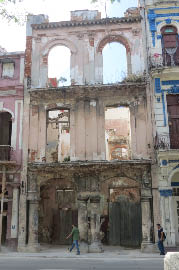
The Real Havana |
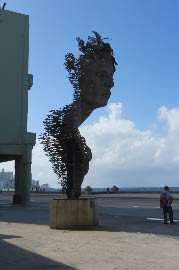
The Real Havana |

The Real Havana |

The Real Havana |
At the Malecon seawall, Bill and I (the older, wimipier couple) opt to take a taxi ride back to hotel. Bill and Judy walk. A friendly driver in an old Chevy takes us back in style (and in fumes)!
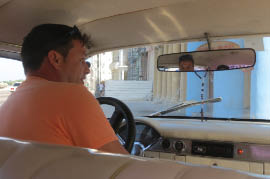
Taxi to Hotel |
 Taxi to Hotel Taxi to Hotel |
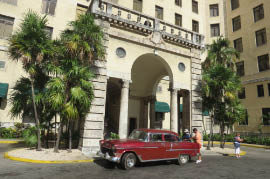
Taxi to Hotel |
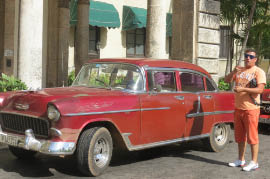
Taxi to Hotel |
NOTE: This odd statue is displayed prominently in the Anti-Imperialist Plaza in Havana. It represents Marti holding the young boy, Elian Gonzales, and pointing his way to the East.
Elian ’s story is still seared into my brain. Elian was 5 when he and his mother boarded a boat destined for Miami. The boat sank. Elian survived, but his mother did not. He was placed with his mother’s parents in Miami. His Cuban father, divorced from the mother, ultimately gained custody of the boy. On April 22, 2000, U.S. officials snatched Elian from his relatives' home in Miami and returned him to Cuba to live with his father. That frightened little boy became a huge pawn in the US / Cuban political arena.

José Martí holding Child |

Snatching Elian |
At the hotel, Coro Vocal Luna, the only all-female choir in Cuba performs for us – a cappella. With thier beautiful voices, they stole our hearts.
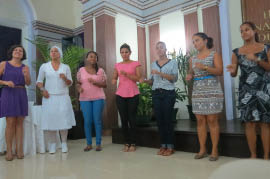
Coro Vocal Luna |
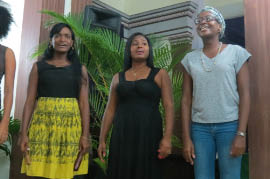 Coro Vocal Luna Coro Vocal Luna |
For our last night in Cuba, Raul planned a big surprise for us--riding to dinner in classic old convertibles. We climbed into our cars with such glee.
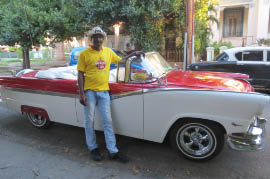
Going to Dinner |
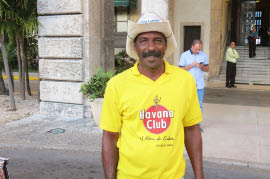 Going to Dinner Going to Dinner |
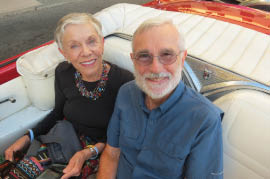
Going to Dinner |
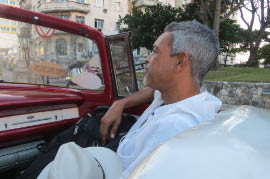 Going to Dinner Going to Dinner |
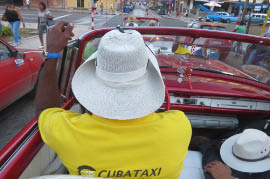
Going to Dinner |
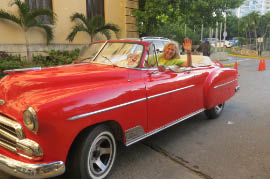 Going to Dinner Going to Dinner |
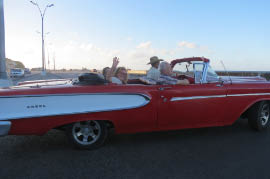
Going to Dinner |
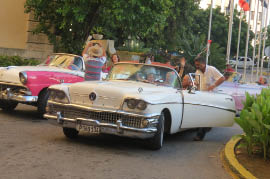 Going to Dinner Going to Dinner |
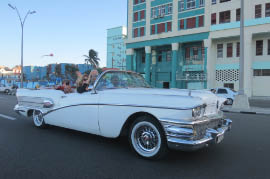
Going to Dinner |
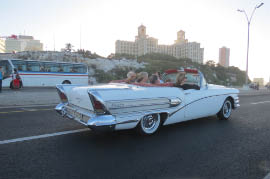 Going to Dinner Going to Dinner |
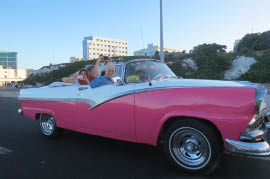
Going to Dinner |
 Going to Dinner Going to Dinner |
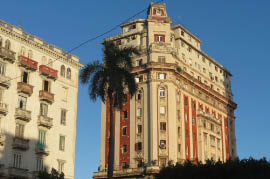
Going to Dinner |
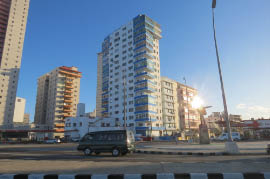 Going to Dinner Going to Dinner |

Going to Dinner |
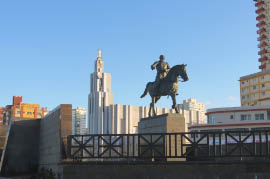 Going to Dinner Going to Dinner |
We drive through parks and circle the Plaza de la Revolución surrounded by the Central Committee of the Communist Party's government buildings, the heart of modern Havana. We get a quick look at the huge murals and Jose Marti’s “Washington-like” monument.

Plaza de la Revolución |
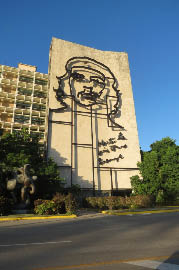
Plaza de la Revolución |

Plaza de la Revolución |

Plaza de la Revolución |
Just as the sun is setting, we arrive at Starbien, a paladar in a restored colonial mansion tucked away in the residential neighborhood of Velado. The ambience was lovely and the food was very good. We are sad that it is our last night together.

At the Restaurant |
 At the Restaurant At the Restaurant |
1019/16
We have an early flight back to Miami. At the baggage claim in Miami, we regroup for one last good-bye.
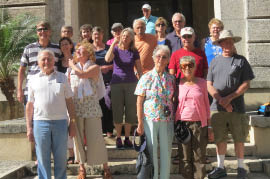
Good Bye, Cuba |
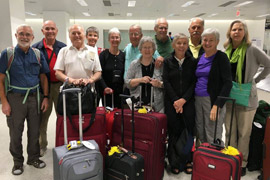 Baggage Claim, Maimi Baggage Claim, Maimi |
The adventure continues on for Bill and Judy and Bill and Nancy--one last great adventure in Miami. (We need to kill some time before catching our evening flight back to San Diego.)
With some help at the Miami airport, we hatch a plan. We take a bus to South Beach, get some lunch and then explore. While we wait for the bus, a nice guy tells us to eat at “Chalan on the Beach” – excellent Peruvian food.
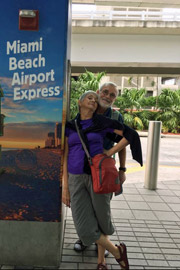
Heading for Miami Beach |

Heading for Miami Beach |
We take the bus and get off at where I think the restaurant is. I manage to screw up both the directions and the name of the restaurant. We eventually find the place. It is late. We are hungry. The place is packed with customers and the service is slow. Beer and food eventually arrive and calm our grumpy spirits. After refueling, we walk around the South Beach – absolutely charming. Being a San Diego snob, I had no idea how wonderful this place is.
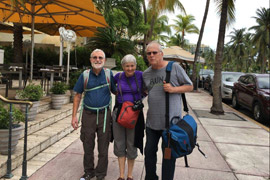
Miami Beach |
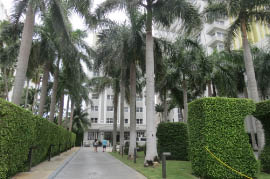 Miami Beach Miami Beach |

Miami Beach |
 Miami Beach Miami Beach |

Miami Beach |
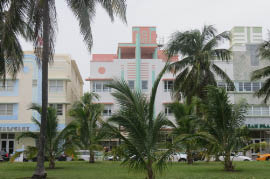 Miami Beach Miami Beach |
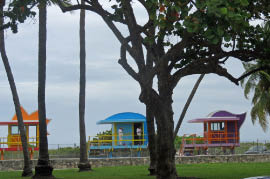
Miami Beach |
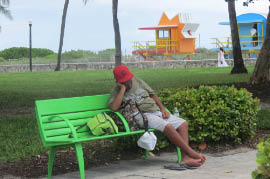 Miami Beach Miami Beach |
Bill and Judy have enough walking and take off in search of a coffee shop, specializing in free wifi while we continue to roam aimlessly around. We stop at an Art Deco museum and learn how one couple saved the neighborhood and the many lovely boutique hotels from the wrecking ball.
We link up with Bill and Judy again. Judy’s Bill is a happy camper because he found an old diner with free wifi along with good coffee and pie. He's nuts about diners and this one is classic 1948 aluminum-sided retro dining car. The original diner started out in Wilkes-Barre, Pennsylvania for its first 44 years before being shipped to the vacant lot at 11 Street and Washington Avenue in the heart of South Beach’s Art Deco nightclub district – where it will, hopefully, live happily ever after.
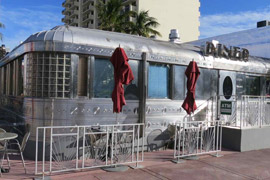
Miami Beach |
 Miami Beach Miami Beach |
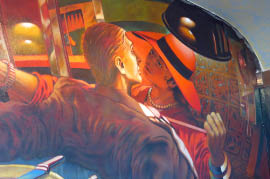
Miami Beach |
 Miami Beach Miami Beach |
Luckily, we allow ourselves plenty of time to get back to the airport on the bus. We spend at least an hour in gridlock traffic.
We board the plane, ready for our nonstop flight to San Diego. My head reruns the memories of our incredible adventure … Nothing like it … and nothing like seeing lights of San Diego, my home right outside my window … There is no place like home
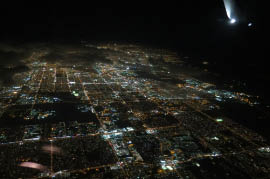
Home Sweet Home |
Attempted Footnote: I have taken at liberty, many notes (and a few photos) from Judy. Many thanks Judy -- However, I am not through with my plagiarizing. Following are a couple of more interesting tidbits by Judy about Cuba.
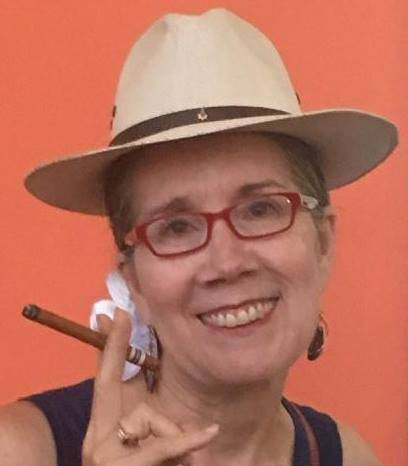
Judy (Cubana) |
Cuba seems to be very safe, judging not just by what Raul said but also by how we were able to walk anywhere anytime.
Raul said there is virtually no rape. If one is convicted of rape, they will die in prison, two rapes - they are executed.
The Cubans joke that there is absolute freedom of speech -- say whatever you want. There's just no freedom after speech – because you many find yourself in jail. But nowadays, people are more open. A number of our speakers and Cuban contacts talked openly about the problems and challenges. We were also encouraged to speak to the locals, who were all very friendly to us.
Quite a few Cubans spoke at least a little English – glad we had Bill who speaks Spanish so we could gain more insight from his translations.
People really do still get around in Cuba on horseback.
40% of the land suitable for farming is owned by the government, only 40 acres maximum can be privately owned by an individual or family.
Under the current embargo, there are US companies with special trading privileges that are desperately opposed to opening up trade to their competitors.
Tourism is the primary industry.
Theoretically, no one in Cuba is unemployed. If you don't have a job, the local government finds you one. There are too many workers in some areas resulting in too many slacker employees.
We saw a lot of hard working people, but also a lot sitting in the parks and squares. Someone explained that people often arrive at work early but then run errands. There's a Cuban saying - "The government pretends to pay you and you pretend to work."
We ate a lot of pork, rice & black beans, guava, papaya and tostones (fried banana slices). Food was good, but for the most part, overcooked.
We dined at a lot of "palamars" - small restaurants privately located in people’s homes. You're served by the family and have an opportunity to visit with them. All very warm and hospitable!
Cuba produces very well-educated people. However, the residents still must live in a limited world where big brother sets up boundaries in so many ways.
There are only political billboards … That may change as capitalism starts to seep in. |











